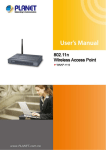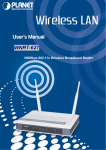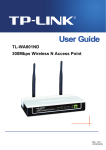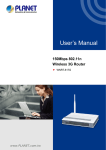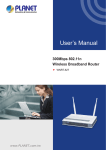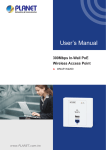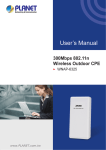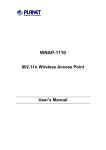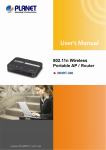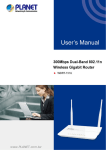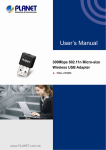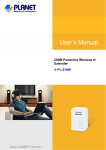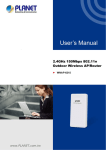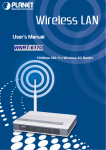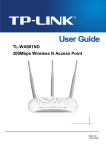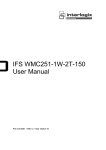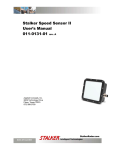Download User Manual
Transcript
I Copyright Copyright 2014 by PLANET Technology Corp. All rights reserved. No part of this publication may be reproduced, transmitted, transcribed, stored in a retrieval system, or translated into any language or computer language, in any form or by any means, electronic, mechanical, magnetic, optical, chemical, manual or otherwise, without the prior written permission of PLANET. PLANET makes no representations or warranties, either expressed or implied, with respect to the contents hereof and specifically disclaims any warranties, merchantability or fitness for any particular purpose. Any software described in this manual is sold or licensed "as is". Should the programs prove defective following their purchase, the buyer (and not this company, its distributor, or its dealer) assumes the entire cost of all necessary servicing, repair, and any incidental or consequential damages resulting from any defect in the software. Further, this company reserves the right to revise this publication and to make changes from time to time in the contents hereof without obligation to notify any person of such revision or changes. All brand and product names mentioned in this manual are trademarks and/or registered trademarks of their respective holders. Federal Communication Commission Interference Statement This equipment has been tested and found to comply with the limits for a Class B digital device, pursuant to Part 15 of FCC Rules. These limits are designed to provide reasonable protection against harmful interference in a residential installation. This equipment generates, uses, and can radiate radio frequency energy and, if not installed and used in accordance with the instructions, may cause harmful interference to radio communications. However, there is no guarantee that interference will not occur in a particular installation. If this equipment does cause harmful interference to radio or television reception, which can be determined by turning the equipment off and on, the user is encouraged to try to correct the interference by one or more of the following measures: 1. Reorient or relocate the receiving antenna. 2. Increase the separation between the equipment and receiver. 3. Connect the equipment into an outlet on a circuit different from that to which the receiver is connected. 4. Consult the dealer or an experienced radio technician for help. FCC Caution: To assure continued compliance, (example-use only shielded interface cables when connecting to computer or peripheral devices) any changes or modifications not expressly approved by the party responsible for compliance could void the user’s authority to operate the equipment. This device complies with Part 15 of the FCC Rules. Operation is subject to the Following two conditions: (1) This device may not cause harmful interference (2) This Device must accept any interference received, including interference that may cause undesired operation. Any changes or modifications not expressly approved by the party responsible for compliance could void the user’s authority to operate the equipment. II Federal Communication Commission (FCC) Radiation Exposure Statement This equipment complies with FCC radiation exposure set forth for an uncontrolled environment. In order to avoid the possibility of exceeding the FCC radio frequency exposure limits, human proximity to the antenna shall not be less than 20 cm (8 inches) during normal operation. R&TTE Compliance Statement This equipment complies with all the requirements of DIRECTIVE 1999/5/CE OF THE EUROPEAN PARLIAMENT AND THE COUNCIL OF 9 March 1999 on radio equipment and telecommunication terminal Equipment and the mutual recognition of their conformity (R&TTE). The R&TTE Directive repeals and replaces in the directive 98/13/EEC (Telecommunications Terminal Equipment and Satellite Earth Station Equipment) As of April 8, 2000. Safety This equipment is designed with the utmost care for the safety of those who install and use it. However, special attention must be paid to the dangers of electric shock and static electricity when working with electrical equipment. All guidelines of this and of the computer manufacture must therefore be allowed at all times to ensure the safe use of the equipment. National Restrictions This device is intended for home and office use in all EU countries (and other countries following the EU directive 1999/5/EC) without any limitation except for the countries mentioned below: Country Restriction Bulgaria None France Reason/remark General authorization required for outdoor use and public service Outdoor use limited to 10 Military Radiolocation use. Refarming of the 2.4 GHz mW e.i.r.p. within the band band has been ongoing in recent years to allow current 2454-2483.5 MHz relaxed regulation. Full implementation planned 2012 Italy None Luxembourg None Norway Implemented Russian None If used outside of own premises, general authorization is required General authorization required for network and service supply(not for spectrum) This subsection does not apply for the geographical area within a radius of 20 km from the centre of Ny-Ålesund Only for indoor applications Federation Note: Please don’t use the product outdoors in France WEEE regulation To avoid the potential effects on the environment and human health as a result of the presence of hazardous substances in electrical and electronic equipment, end users of electrical and electronic equipment should understand the meaning of the crossed-out wheeled bin symbol. Do not dispose of WEEE as unsorted municipal waste and have to collect such WEEE separately. III Revision User’s Manual for PLANET 0ESV802.11n Wireless Range Extender Model: WNAP-1110 Rev: 2.0 (February, 2014) Part No. EM-WNAP-1110v2_v2.0 (2081-E10350-002) IV CONTENTS Chapter 1. Product Introduction.........................................................................................................10 1.1 Package Contents...............................................................................................................10 1.2 Product Description.............................................................................................................10 1.3 Product Features................................................................................................................. 11 1.4 Product Specifications.........................................................................................................12 Chapter 2. Hardware Installation ........................................................................................................14 2.1 Hardware Description..........................................................................................................14 2.1.1 The Front Panel ......................................................................................................14 2.1.2 The Rear Panel.......................................................................................................15 Chapter 3. Connecting the AP ............................................................................................................17 3.1 System Requirements.........................................................................................................17 3.2 Installing the AP ..................................................................................................................17 Chapter 4. Quick Installation Guide ...................................................................................................21 4.1 Manual Network Setup - TCP/IP Configuration ..................................................................21 4.1.1 4.2 Configuring the IP Address Manually .....................................................................21 Starting Setup in Web UI.....................................................................................................25 Chapter 5. Configuring the AP............................................................................................................29 5.1 Status ..................................................................................................................................29 5.2 Quick Setup.........................................................................................................................31 5.3 Operation Mode ..................................................................................................................31 5.3.1 Operation Mode – Access Point .............................................................................32 5.3.2 Operation Mode – Multi-SSID.................................................................................34 5.3.3 Operation Mode – Repeater (Range Extender) .....................................................38 5.3.4 Operation Mode – Bridge with AP ..........................................................................44 5.3.5 Operation Mode – Client.........................................................................................49 5.4 WPS ....................................................................................................................................52 5.5 Network ...............................................................................................................................56 5.5.1 5.6 LAN .........................................................................................................................56 Wireless...............................................................................................................................58 5.6.1 Wireless Settings ....................................................................................................58 5.6.2 Wireless Security ....................................................................................................60 5.6.3 Wireless MAC Filtering ...........................................................................................65 5.6.4 Wireless Advanced .................................................................................................68 5.6.5 Antenna Alignment..................................................................................................69 V 5.7 5.8 5.6.6 Throughput Monitor ................................................................................................70 5.6.7 Wireless Statistics...................................................................................................71 DHCP ..................................................................................................................................72 5.7.1 DHCP Settings........................................................................................................72 5.7.2 DHCP Clients List ...................................................................................................74 5.7.3 Address Reservation ..............................................................................................75 System Tools .......................................................................................................................77 5.8.1 SNMP......................................................................................................................77 5.8.2 Time Settings ..........................................................................................................79 5.8.3 Diagnostic ...............................................................................................................81 5.8.4 Ping Watch Dog ......................................................................................................84 5.8.5 Firmware Upgrade ..................................................................................................84 5.8.6 Factory Defaults......................................................................................................85 5.8.7 Backup & Restore...................................................................................................86 5.8.8 Reboot ....................................................................................................................87 5.8.9 Password ................................................................................................................87 5.8.10 System Log.............................................................................................................89 5.8.11 Statistics..................................................................................................................92 Chapter 6. Quick Connection to a Wireless Network .......................................................................94 6.1 Windows XP (Wireless Zero Configuration)........................................................................94 6.2 Windows 7 (WLAN AutoConfig) ..........................................................................................96 6.3 Mac OS X 10.x ....................................................................................................................99 6.4 iPhone / iPod Touch / iPad ................................................................................................101 Appendix A: Planet Smart Discovery Utility ......................................................................................105 Appendix B: Factory Default Settings................................................................................................106 Appendix C: Troubleshooting .............................................................................................................107 Appendix D: Specifications.................................................................................................................109 Appendix E: Glossary .......................................................................................................................... 110 VI FIGURE FIGURE 2-1 WNAP-1110 FRONT PANEL .................................................................................................14 FIGURE 2-2 WNAP-1110 REAR PANEL...................................................................................................15 FIGURE 3-1 ADJUST THE DIRECTION OF THE ANTENNA .............................................................................18 FIGURE 3-2 HARDWARE INSTALLATION OF THE WNAP-1110 WIRELESS AP..............................................19 FIGURE 3-3 HARDWARE INSTALLATION OF THE WNAP-1110 WIRELESS AP..............................................19 FIGURE 4-1 TCP/IP SETTING .................................................................................................................22 FIGURE 4-2 WINDOWS START MENU ......................................................................................................23 FIGURE 4-3 SUCCESSFUL RESULT OF PING COMMAND .............................................................................23 FIGURE 4-4 FAILED RESULT OF PING COMMAND ......................................................................................24 FIGURE 4-5 LOGIN THE AP.....................................................................................................................25 FIGURE 4-6 LOGIN WINDOW ..................................................................................................................25 FIGURE 4-7 WNAP-1110 QUICK SETUP .................................................................................................26 FIGURE 4-8 QUICK SETUP – OPERATION MODE ......................................................................................26 FIGURE 4-9 QUICK SETUP – WIRELESS ..................................................................................................27 FIGURE 4-10 QUICK SETUP – NETWORK ................................................................................................27 FIGURE 4-11 QUICK SETUP – FINISH ......................................................................................................28 FIGURE 4-12 BASIC WIRELESS INTERNET CONNECTION ..........................................................................28 FIGURE 5-1 MAIN MENU ........................................................................................................................29 FIGURE 5-2 STATUS ...............................................................................................................................30 FIGURE 5-3 OPERATION MODE...............................................................................................................31 FIGURE 5-4 WIRELESS – AP MODE ........................................................................................................33 FIGURE 5-5 TOPOLOGY – AP MODE .......................................................................................................33 FIGURE 5-6 OPERATION MODE – MULTI-SSID ........................................................................................34 FIGURE 5-7 TOPOLOGY – MULTI-SSID ...................................................................................................36 FIGURE 5-8 MULTI-SSID – ENABLE VLAN..............................................................................................36 FIGURE 5-9 MULTI-SSID – VLAN TOPOLOGY .........................................................................................38 FIGURE 5-10 OPERATION MODE - REPEATER (RANGE EXTENDER)...........................................................39 FIGURE 5-11 TOPOLOGY – UNIVERSAL REPEATER ..................................................................................39 FIGURE 5-12 REPEATER (RANGE EXTENDER) – UNIVERSAL REPEATER ....................................................40 FIGURE 5-13 TOPOLOGY – WDS REPEATER ...........................................................................................40 FIGURE 5-14 REPEATER (RANGE EXTENDER) – WDS REPEATER ............................................................41 FIGURE 5-15 REPEATER (RANGE EXTENDER) – SURVEY .........................................................................42 FIGURE 5-16 REPEATER (RANGE EXTENDER) – AP LIST .........................................................................43 FIGURE 5-17 REPEATER (RANGE EXTENDER) – FINISH SETTING ..............................................................43 FIGURE 5-18 REPEATER (RANGE EXTENDER) – SECURITY ......................................................................44 FIGURE 5-19 REPEATER (RANGE EXTENDER) – STATUS ..........................................................................44 FIGURE 5-20 OPERATION MODE - BRIDGE WITH AP ................................................................................45 FIGURE 5-21 TOPOLOGY - BRIDGE WITH AP ...........................................................................................46 VII FIGURE 5-22 BRIDGE WITH AP – SURVEY ...............................................................................................47 FIGURE 5-23 BRIDGE WITH AP – AP LIST ...............................................................................................47 FIGURE 5-24 BRIDGE WITH AP – FINISH SETTING ...................................................................................48 FIGURE 5-25 BRIDGE WITH AP – STATUS ................................................................................................48 FIGURE 5-26 WIRELESS - CLIENT ...........................................................................................................49 FIGURE 5-27 TOPOLOGY – CLIENT MODE ...............................................................................................50 FIGURE 5-28 CLIENT – SURVEY .............................................................................................................50 FIGURE 5-29 CLIENT – AP LIST ..............................................................................................................51 FIGURE 5-30 CLIENT – FINISH SETTING ..................................................................................................51 FIGURE 5-31 CLIENT – STATUS ..............................................................................................................52 FIGURE 5-32 WPS................................................................................................................................52 FIGURE 5-33 HARDWARE WPS BUTTON.................................................................................................53 FIGURE 5-34 SOFTWARE WPS BUTTON .................................................................................................53 FIGURE 5-35 ADD A NEW DEVICE ............................................................................................................54 FIGURE 5-36 NEW DEVICE CONNECT SUCCESSFULLY...............................................................................55 FIGURE 5-37 THE NETWORK MENU ........................................................................................................56 FIGURE 5-38 LAN SETTINGS .................................................................................................................56 FIGURE 5-39 WIRELESS MENU ...............................................................................................................58 FIGURE 5-40 WIRELESS SETTINGS .........................................................................................................58 FIGURE 5-41 WIRELESS SECURITY ........................................................................................................60 FIGURE 5-42 WIRELESS SECURITY – WEP.............................................................................................61 FIGURE 5-43 WIRELESS SECURITY - WPA/WPA2 ENTERPRISE ...............................................................62 FIGURE 5-44 WIRELESS SECURITY - WPA/WPA2 PERSONAL ..................................................................63 FIGURE 5-45 WIRELESS MAC ADDRESS FILTERING ................................................................................65 FIGURE 5-46 ADD OR MODIFY WIRELESS MAC ADDRESS FILTERING ENTRY ............................................66 FIGURE 5-47 WIRELESS MAC ADDRESS FILTERING ................................................................................67 FIGURE 5-48 WIRELESS ADVANCED .......................................................................................................68 FIGURE 5-49 ANTENNA ALIGNMENT ........................................................................................................69 FIGURE 5-50 THROUGHPUT MONITOR ....................................................................................................70 FIGURE 5-51 THE AP ATTACHED WIRELESS STATIONS ..............................................................................71 FIGURE 5-52 THE DHCP MENU..............................................................................................................72 FIGURE 5-53 DHCP SETTINGS ..............................................................................................................73 FIGURE 5-54 DHCP CLIENTS LIST .........................................................................................................74 FIGURE 5-55 ADDRESS RESERVATION ....................................................................................................75 FIGURE 5-56 ADD AN ADDRESS RESERVATION ENTRY .............................................................................76 FIGURE 5-57 MODIFY AN ADDRESS RESERVATION ENTRY ........................................................................76 FIGURE 5-58 THE SYSTEM TOOLS MENU ................................................................................................77 FIGURE 5-59 THE SYSTEM TOOLS MENU ................................................................................................78 FIGURE 5-60 TIME SETTINGS .................................................................................................................79 FIGURE 5-61 DIAGNOSTIC TOOLS...........................................................................................................81 VIII FIGURE 5-62 DIAGNOSTIC RESULTS .......................................................................................................83 FIGURE 5-63 PING WATCH DOG .............................................................................................................84 FIGURE 5-64 FIRMWARE UPGRADE ........................................................................................................85 FIGURE 5-65 RESTORE FACTORY DEFAULT .............................................................................................86 FIGURE 5-66 BACKUP & RESTORE CONFIGURATION ................................................................................86 FIGURE 5-67 REBOOT THE AP ...............................................................................................................87 FIGURE 5-68 PASSWORD .......................................................................................................................88 FIGURE 5-69 SYSTEM LOG ....................................................................................................................89 FIGURE 5-70 MAIL ACCOUNT SETTINGS ..................................................................................................90 FIGURE 5-71 STATISTICS .......................................................................................................................92 FIGURE 6-1 WIRELESS ZERO CONFIGURATION ........................................................................................94 FIGURE 6-2 VIEW AVAILABLE WIRELESS NETWORKS ...............................................................................94 FIGURE 6-3 CHOOSE A WIRELESS NETWORK ...........................................................................................95 FIGURE 6-4 ENTER THE ENCRYPTION KEY ...............................................................................................95 FIGURE 6-5 WIRELESS NETWORK CONNECTED .......................................................................................96 FIGURE 6-6 WLAN AUTOCONFIG ...........................................................................................................96 FIGURE 6-7 WLAN AUTOCONFIG WINDOW .............................................................................................97 FIGURE 6-8 WLAN AUTOCONFIG – TYPE THE NETWORK SECURITY KEY ...................................................98 FIGURE 6-9 WLAN AUTOCONFIG – CONNECTING....................................................................................98 FIGURE 6-10 WLAN AUTOCONFIG – CONNECTED ..................................................................................99 FIGURE 6-11 THE AIRPORT NETWORK CONNECTION ICON .......................................................................99 FIGURE 6-12 THE AIRPORT NETWORK CONNECTION MENU ...................................................................100 FIGURE 6-13 THE AIRPORT NETWORK CONNECTION – ENTER PASSWORD..............................................100 FIGURE 6-14 THE AIRPORT NETWORK CONNECTION – CONNECTED.......................................................101 FIGURE 6-15 THE WI-FI SETTINGS IN IPHONE/IPOD TOUCH/IPAD ...........................................................101 FIGURE 6-16 GENERAL SETTINGS ........................................................................................................102 FIGURE 6-17 GENERAL SETTINGS – NOT CONNECTED ..........................................................................102 FIGURE 6-18 GENERAL SETTINGS – WI-FI ON ......................................................................................103 FIGURE 6-19 GENERAL SETTINGS – ENTER PASSWORD.........................................................................104 FIGURE 6-20 GENERAL SETTINGS – WI-FI NETWORK CONNECTED ........................................................104 IX User’s Manual of WNAP-1110 Chapter 1. Product Introduction 1.1 Package Contents The following items should be contained in the package: WNAP-1110 Wireless Range Extender Power Adapter Passive PoE Injector 4dBi Antenna x1 Quick Installation Guide CD-ROM (User’s Manual included) If there is any item missing or damaged, please contact the seller immediately. 1.2 Product Description PLANET 802.11n Wireless Access Point (WNAP-1110) features 802.11n radio with 1T1R MIMO technology. It is also backward compliant with 802.11b/g standard. Compared with simple Access Point, the WNAP-1110 offers more powerful, flexible capability for wireless client to access Internet. The WNAP-1110 provides multiple operation modes including AP (Multi-SSID), Client, Repeater, Universal Repeater (Range Extender), and WDS Bridge (Point to Point and Point to Multiple Points) that can play different roles in different situations. To secure the wireless communications, the WNAP-1110 supports 64/128/152-bit WEP encryption, WiFi Protected Access (WPA/WPA2, WPA-PSK/WPA2-PSK). Furthermore, in order to simplify the security settings, the WNAP-1110 supports WPS configuration with the PBC/PIN type. Your whole wireless network can be secured within a few seconds. Being an Access Point, the WNAP-1110 supports the VLAN function to allow multiple SSIDs (Four sets of SSID and tagging VID) to access Internal VLAN topology via the VLAN Switch function. Moreover, WMM capability can provide better service to selected traffic or application, which utilizes the network usage. In the wireless security aspect, the WNAP-1110 supplies MAC address filtering which prevents possible hackers attack. The WNAP-1110 provides a total solution for the Small Office and the SOHO users. With the MIMO 11n wireless technology, it’s easy to combine the wireless devices with the existing wired network. -10- User’s Manual of WNAP-1110 1.3 Product Features Standard Compliant Hardware Interface 150Mbps wireless transmission rate with MIMO technology IEEE 802.11n, 802.11b/g standard compliant 1 x 10/100Base-TX Port with Passive PoE supported Secure Network Connection Advanced security: 64/128/152-bit WEP, WPA/WPA2, WPA-PSK/WPA2-PSK (TKIP/AES encryption) and 802.1X Radius Authentication Easy setup secure wireless connection by one-touch WPS (Wi-Fi Protected Setup) button Supports MAC address filtering Supports multiple SSIDs to allow users to access different networks through a single AP Wireless Network Range Extender Multiple wireless modes: AP, WDS, Repeater, Universal Repeater, Client Supports WMM (Wi-Fi Multimedia), wireless QoS Supports wireless roaming Easy Installation & Management Flexible deployment with passive PoE/PD supported Web-based UI and Quick Setup Wizard for easy configuration SNMP-based management interface -11- User’s Manual of WNAP-1110 1.4 Product Specifications Product WNAP-1110 150Mbps 802.11n Wireless Range Extender Hardware Specifications 1 x 10/100Mbps Auto MDI/MDI-X RJ45 port Interface PoE LAN Port: PoE Passive PoE (Up to 30 meters) Antenna Detachable 4dBi antenna x1 Button ※ Passive PoE/PD Port WPS Button Press the WPS button on the front panel of the device. Reset Button Press for about 5 seconds to reset the device to factory default. LED Indicators PWR/SYS/LAN/WLAN/WPS LED Material Plastic Dimensions (W x D x H) 174 x 110 x 23 mm Weight 250g Power Requirements 9V DC, 0.85A or Passive PoE Power Consumption 2W (max.) Wireless interface Specifications Standard Compliance with IEEE 802.11b/g/n Frequency Band 2.4~2.4835GHz Extended Frequency DSSS Modulation Type DBPSK, DQPSK, QPSK, CCK and OFDM (BPSK/ QPSK/ 16-QAM/ 64-QAM) IEEE 802.11n: up to 150Mbps(Dynamic) Data Transmission Rates IEEE 802.11g: 54/48/36/24/18/12/9/6Mbps (Dynamic) IEEE 802.11b: 11/5.5/2/1Mbps (Dynamic) America/ FCC: 2.414~2.462GHz (11 Channels) Frequency Band Europe/ ETSI: 2.412~2.472GHz (13 Channels) Japan/ TELEC: 2.412~2.484GHz (14 Channels) Channel Width Transmission Distance Max. RF Power (Intentional Radiator) 20 or 40MHz Indoor up to 100m Outdoor up to 300m (it is limited to the environment) IEEE 802.11b: 18dBm IEEE 802.11g: 15dBm IEEE 802.11n: 15dBm 130M: -70dBm@10% PER 108M: -72dBm@10% PER Receive Sensitivity 54M: -74dBm@10% PER 11M: -86dBm@8% PER 6M: -91dBm@10% PER 1M: -91dBm@8% PER Wireless Management Features Wireless Modes AP (Multi-SSID) -12- User’s Manual of WNAP-1110 WDS Repeater (WDS+AP) Universal Repeater (AP+Client) Client WEP (64/128/152-bit) Encryption Security WPA-PSK (TKIP) / WPA2-PSK (AES) WPA (TKIP) / WPA2 (AES) 802.1x Authentication Wireless Security Enable/Disable SSID Broadcast Wireless LAN ACL (Access Control List) MAC filtering AP Isolation: Enable it to isolate each connected wireless client to let them cannot access Wireless Advanced mutually. Supports 802.11e WMM (Wi-Fi Multimedia) Max. Supported Clients Wired: 32 Wireless: 20 Web-based (HTTP) management interface Supports SNMP v1/v2 System Management Supports Planet Smart Discovery Supports Scheduling Reboot System Log -13- User’s Manual of WNAP-1110 Chapter 2. Hardware Installation Please follow the instructions below to build the wireless network connection between WNAP-1110 and your computers. 2.1 Hardware Description 2.1.1 The Front Panel The front panel provides a simple interface monitoring the AP. Figure 2-1 shows the front panel of WNAP-1110. Front Panel PWR SYS LAN WLAN WPS WPS WNAP-1110 Power LED System LED LAN LED WPS Button WPS LED Wireless LED Figure 2-1 WNAP-1110 Front Panel LED definition Object Color PWR Green SYSTEM Green LAN Green State Description On Device power on Off Device power off On Device is initialising Flash The device is working properly Off The device has a system error On There is a device linked to the corresponding port but no activity Flash Packets are transmitting or receiving Off LAN port is not connected -14- User’s Manual of WNAP-1110 WLAN Green Flash The Wireless function is enabled Off The Wireless function is disabled A wireless device has been successfully added to the network by On WPS Green WPS function. A wireless device is connecting to the network by WPS function. Slow Flash This process will last in the first 2 minutes. Quick Flash 2.1.2 A wireless device failed to be added to the network by WPS function. The Rear Panel The rear panel of the WNAP-1110 consists of buttons, connection port, and power connector. Figure 2-2 shows the hardware interface of WNAP-1110. Rear Panel 4dBi Antenna 10/100Mbps LAN Port Power ON/OFF Button Power Connector 9V DC Input Reset POWER ON/OFF LAN Reset Button (Press and hold the Reset button for about 5 seconds for factory default) Figure 2-2 WNAP-1110 Rear Panel Button definition Object WPS Power ON/OFF Reset Description Press the button for less than 3 seconds for WPS configuration. Press the button to power on the device. Press and hold the button for about 5 seconds to the factory default setting. -15- User’s Manual of WNAP-1110 H/W Interface definition Object Antenna LAN (Passive PoE) LAN Power Connector Description Detachable 4dBi Antenna with RP-SMA (male) connector. 10/100Mbps RJ-45 port, Auto MDI/ MDI-X & Passive PoE supported Connect LAN port to the PoE injector to power on the device. 10/100Mbps RJ-45 port, Auto MDI/ MDI-X Connect this port to the LAN port of the Router or Ethernet Switch. Connect this port to the 9V DC power adapter to power on the device. The WNAP-1110 supports only 9VDC power adapter or passive POE injector (RJ45 pin 4, 5: +; pin 7, 8: -). It cannot work with IEEE 802.3af PSE for its power source. ! At the same time, either 9V DC adapter from the DC-jack or passive PoE injector from the UTP LAN port can be connected to the device at one time. Use of two power sources will damage the device permanently. -16- User’s Manual of WNAP-1110 Chapter 3. Connecting the AP 3.1 System Requirements Broadband Internet Access Service (DSL/Cable/Ethernet connection) One DSL/Cable Modem that has an RJ-45 connector (not necessary if the AP is connected directly to the Ethernet.) PCs with a working Ethernet adapter and an Ethernet cable with RJ-45 connectors Subscribers can utilize Windows 98/ME, NT4.0, 2000/XP, Windows Vista / Win 7, MAC OS 9 or later, Linux, UNIX or other platforms compatible with TCP/IP protocols The above PC is installed with a Web browser It is recommended to use Internet Explore 7.0 or above to access the AP. 3.2 Installing the AP Before installing the AP, make sure your PC is connected to the Internet through the broadband service successfully at this moment. If there is any problem, please contact your local ISP. After that, please install the AP according to the following steps. Don't forget to pull out the power plug and keep your hands dry. Step 1. Power off your PC, Cable/DSL Modem, and the AP. Step 2. Locate an optimum location for the AP. The best place is usually at the center of your wireless network. Step 3. Adjust the direction of the antenna. Normally, upright is a good direction. -17- User’s Manual of WNAP-1110 Figure 3-1 Adjust the direction of the antenna Step 4. Connect the Power Source to the WNAP-1110. Only choose one of the following methods for the suitability of AP’s location; otherwise, it will cause damage to the WNAP-1110. Method A -- Hard to find the power socket (1) Connect the Ethernet cable to the LAN port of the PC, and plug the other end of the Ethernet cable into the LAN port of the PoE injector. (2) Use another Ethernet cable (8-wire patch cable) to connect the LAN port of the WNAP-1110 and the PoE port of the PoE Injector. ※ The 8-wire patch cable should not exceed 30 meters in length. (3) Connect the power adapter to the DC port of the PoE injector, and plug the other end of the power adapter into an electrical outlet. Method B -- Power Socket nearby (1) Connect the Ethernet cable to the LAN port of the PC, and plug the other end of the Ethernet cable into the LAN port of the WNAP-1110. (2) Connect the power adapter into the POWER port of the WNAP-1110 in the rear panel, and plug the other end of the power adapter into an electrical outlet. -18- User’s Manual of WNAP-1110 Method A – Hard to find the power socket Power POWER PoE LAN 1 PC 3 POWER PoE LAN Reset PoE Injector POWER ON/OFF LAN 2 Figure 3-2 Hardware Installation of the WNAP-1110 Wireless AP Check connection before powering on. Wrong connection may cause device malfunction, say, your PC or other Ethernet device. Method B – Power Socket nearby 1 Reset POWER ON/OFF LAN Power PC 2 Figure 3-3 Hardware Installation of the WNAP-1110 Wireless AP -19- User’s Manual of WNAP-1110 Step 5. Connect the power adapter to the power socket on the AP, and the other end into an electrical outlet. Then power on the AP. Step 6. Power on your PC and Cable/DSL Modem. -20- User’s Manual of WNAP-1110 Chapter 4. Quick Installation Guide This chapter will show you how to configure the basic functions of your AP using Quick Setup within minutes. A computer with wired Ethernet connection to the Wireless AP is required for the first-time configuration. 4.1 Manual Network Setup - TCP/IP Configuration The default IP address of the WNAP-1110 is 192.168.1.253. And the default Subnet Mask is 255.255.255.0. These values can be changed as you want. In this guide, we use all the default values for description. Connect the WNAP-1110 to your PC with an Ethernet cable plugging in LAN port on one side and in LAN port of PC on the other side. Please power on the WNAP-1110 by PoE switch through the PoE port. In the following sections, we’ll introduce how to install and configure the TCP/IP correctly in Windows 7. And the procedures in other operating systems are similar. First, make sure your Ethernet adapter is working, and refer to the Ethernet adapter manual if needed. 4.1.1 Configuring the IP Address Manually Summary: Set up the TCP/IP Protocol for your PC. Configure the network parameters. The IP address is 192.168.1.xxx (if the default IP address of the WNAP-1110 is 192.168.1.253, and the DSL router is 192.168.1.254, the "xxx" can be configured to any number from 1 to 252), and Subnet Mask is 255.255.255.0. 1 Select Use the following IP address radio button, and then configure the IP address of the PC. 2 For example, as the default IP address of the WNAP-1110 is 192.168.1.253 and the DSL router is 192.168.1.254, you may choose from 192.168.1.1 to 192.168.1.252. -21- User’s Manual of WNAP-1110 Figure 4-1 TCP/IP Setting Now click OK to save your settings. Now, you can run the Ping command in the command prompt to verify the network connection between your PC and the AP. The following example is in Windows 7 OS. Please follow the steps below: 1. Click on Start > Run. 2. Type “cmd” in the Search box. -22- User’s Manual of WNAP-1110 Figure 4-2 Windows Start Menu 3. Open a command prompt, and type ping 192.168.1.253, and then press Enter. If the result displayed is similar to Figure 4-3, it means the connection between your PC and the AP has been established well. Figure 4-3 Successful result of Ping command If the result displayed is similar to Figure 4-4, it means the connection between your PC and the AP has failed. -23- User’s Manual of WNAP-1110 Figure 4-4 Failed result of Ping command If the address is 0.0.0.0, check your adapter installation, security settings, and the settings on your AP. Some firewall software programs may block a DHCP request on newly installed adapters. -24- User’s Manual of WNAP-1110 4.2 Starting Setup in Web UI It is easy to configure and manage the WNAP-1110 with web browser. Step 1. To access the configuration utility, open a web-browser and enter the default IP address http://192.168.1.253 in the address field of the browser. Figure 4-5 Login the AP After a moment, a login window will appear. Enter admin for the User Name and Password, both in lower case letters. Then click the OK button or press the Enter key. Figure 4-6 Login Window Default User Name: admin Default Password: admin Default SSID: WNAP-1110 Default Wireless Password: PIN code (refer to the label on the bottom of the WNAP-1110.) If the above screen does not pop up, it may mean that your web-browser has been set to a proxy. Go to Tools menu>Internet Options>Connections>LAN Settings, in the screen that appears, cancel the Using Proxy checkbox, and click OK to finish it. Step 2. After successfully login, you can click the Quick Setup to quickly configure your AP. -25- User’s Manual of WNAP-1110 Figure 4-7 WNAP-1110 Quick Setup Step 3. Select the proper operation mode according to your needs. Figure 4-8 Quick Setup – Operation Mode Click Next, and then Wireless Setting page will appear, shown in Figure 4-9. Step 4. Enter a string of up to 32 characters into the SSID field. Then select one of the supported security options and configure the password for your wireless network. -26- User’s Manual of WNAP-1110 Figure 4-9 Quick Setup – Wireless Step 5. Click Next to continue. The Network settings page will appear as shown in Figure 4-10. You can configure the IP parameters of LAN on this page. Figure 4-10 Quick Setup – Network Step 6. Click the Next button. You will then see the Finish page. -27- User’s Manual of WNAP-1110 Figure 4-11 Quick Setup – Finish Step 7. Once the basic configuration is done, connect the WNAP-1110 with the xDSL modem/ router through the Ethernet cable. Then, you will be able to surf the Internet using the wireless client through the WNAP-1110. Figure 4-12 Basic Wireless Internet Connection -28- User’s Manual of WNAP-1110 Chapter 5. Configuring the AP This chapter delivers a detailed presentation of AP’s functionalities and features under main menu below, allowing you to manage the AP with ease. Figure 5-1 Main Menu 5.1 Status On this page, you can view information about the current running status of the WNAP-1110, including LAN interface, wireless interface settings and status, and firmware version information. -29- User’s Manual of WNAP-1110 Figure 5-2 Status This section allows you to view the AP’s basic info listed below: Object Description Firmware Version Displays the current firmware version. Hardware Version Displays the current hardware version. MAC Address Displays AP’s LAN MAC address. IP Address Displays LAN IP address. -30- User’s Manual of WNAP-1110 Subnet Mask Displays LAN subnet mask. Operation Mode Displays AP’s current operation mode. Name (SSID) Displays AP’s SSID. Channel Displays AP’s current channel. Mode Displays AP’s current wireless mode. Channel Width Displays AP’s current wireless channel width. MAC Address Displays AP’s Wireless MAC address. Traffic Statistics Displays the AP's traffic statistics. System Up Time Displays the System Up Time. 5.2 Quick Setup Please refer to Chapter 4.2 Starting Setup in Web UI. 5.3 Operation Mode Figure 5-3 Operation Mode -31- User’s Manual of WNAP-1110 The page includes the following fields: Object Description In this mode, the device will act as a wireless central hub for your wireless LAN AP clients, giving a wireless extension for your current wired network. In this mode, the device can create up to 4 wireless networks labeled with Multi-SSID different SSIDs and assign each SSID with different security or VLAN, especially for the situation when the various access policies and functions are required. Repeater(Range In this mode, the device can copy and reinforce the existing wireless signal to Extender) extend the coverage of the signal, especially for a large space to eliminate signal-blind corners. Bridge with AP In this mode, the device can be used to combine multiple local networks together to the same one via wireless connections, especially for a home or office where separated networks can't be connected easily together with a cable. Client In this mode, the device can be connected to another device via Ethernet port and act as an adaptor to grant your wired devices access to a wireless network, especially for a Smart TV, Media Player, or game console only with an Ethernet port. Be sure to click the Save button to save your settings on this page. The device will reboot automatically after you click the Save button. When you change the operation mode to Client/Repeater, WPS function will stay disabled. Please manually enable this function if needed when you switch back to Access Point/Multi-SSID/Bridge mode. 5.3.1 Operation Mode – Access Point Choose menu “Quick Setup → Next → Access Point”, or “Operation Mode → Access Point” to configure the device as a general wireless access point. -32- User’s Manual of WNAP-1110 Figure 5-4 Wireless – AP Mode For the definition of each field on this page, please refer to Chapter 5.6.1 Wireless Setting. Example of quickly set up a wireless network using AP Mode: To configure each wireless parameter, please go to the “Wireless → Wireless Settings” page. Figure 5-5 Topology – AP Mode Step 1. Create an easy-to-remember name for your wireless network, write it into Wireless Network Name (SSID). -33- User’s Manual of WNAP-1110 Step 2. Select the Most Secure (WPA/WPA2-PSK) encryption mode and enter a password below to prevent unauthorized access to your AP. Step 3. Click Next and you will then come to the Network Setting page for further configuration. Step 4. Refer to Step 5 of Chapter 4.2 to continue the setting. Then, refer to Chapter 6 to quickly connect to a wireless Network. 5.3.2 Operation Mode – Multi-SSID Choose menu “Quick Setup → Next → Multi-SSID”, or “Operation Mode → Multi-SSID” to configure the device as a general wireless access point with multiple SSIDs. Figure 5-6 Operation Mode – Multi-SSID The page includes the following fields: Object Enable VLAN Description Check this box and then you can change the VLAN ID of each SSID. If you want to configure the Guest and Internal networks on VLAN, the switch you are using must support VLAN. As a prerequisite step, configure a port on the switch for handling VLAN tagged packets as described in the IEEE802.1Q standard, and enable this field. SSID (1-4) Up to 4 SSIDs for each BSS can be entered in the field like SSID1 ~ SSID4. The name can be up to 32 characters. The same name (SSID) must be assigned to all wireless devices in your network. If Enable VLAN is checked, the wireless stations connecting to SSID of a different VLANID cannot communicate with each -34- User’s Manual of WNAP-1110 other. VLAN ID (1-4) Provide a number between 1 and 4095 for VLAN. This will cause the AP to send packets with VLAN tags. The switch connecting with the AP must support VLAN IEEE802.1Q frames. The wireless stations connecting to the SSID of a specified VLANID can communicate with the PC connecting to the port with the same VLANID on the Switch. Channel Determines the operating frequency to be used. It is not necessary to change the wireless channel unless you notice interference problems with another nearby access point. Mode This field determines the wireless mode which the device works on. 11b only - Only 802.11b wireless stations can connect to the AP. 11g only - Only 802.11g wireless stations can connect to the AP. 11n only - Only 802.11n wireless stations can connect to the AP. 11bg mixed - Both 802.11b and 802.11g wireless stations can connect to the AP. 11bgn mixed - All 802.11b, 802.11g and 802.11n wireless stations can connect to the AP. Channel Width Determines the channel width to be used. It is unnecessary to change the default value unless required. Enable Wireless Radio Select or deselect this check box to allow or deny wireless stations to access the AP. Enable SSID Broadcast Select or deselect this check box to allow or deny the AP to broadcast its name (SSID) on the air. If it’s allowed, when wireless clients survey the local area for wireless networks to associate with, they will detect the SSID broadcast by the AP. You are suggested to implement Multi-SSID function with a switch that supports Tag VLAN feature. -35- User’s Manual of WNAP-1110 Example of how to configure Multi-SSID Mode. Please take the following steps: To configure each wireless parameter, please go to the “Wireless → Wireless Settings” page. Figure 5-7 Topology – Multi-SSID 1. Configuring the Access Point Figure 5-8 Multi-SSID – Enable VLAN Step 1. Select the checkbox “Enable VLAN” to enable VLAN function for this access point. -36- User’s Manual of WNAP-1110 Step 2. Configure the SSID and its corresponding VLAN ID. The detailed parameters are shown as the figure above. Step 3. STA1, STA2, STA3 and STA4 join to the wireless network with SSID1, SSID2, SSID3 and SSID4, respectively. Step 4. Click Save to apply the current security settings for the selected SSID. 1. The wireless STAs, joined to the network with different VLAN IDs, cannot communicate with each other, for example, STA1 and STA2. 2. The wireless STAs, joined to the network with the same VLAN ID, can communicate with each other, for example, STA1 and STA3. 3. All wireless STAs can log on to the Web management page of the WNAP-1110 and manage the access point, for example, STA1, STA2, STA3 and STA4. 4. All the packets received in the wired network from the wireless STA will be added a corresponding VLAN Tag of the wireless STA, unless the VLAN ID of the wireless network is set to 1. 2. Configuring the Switch Step 1. Enable 802.1Q Tag VLAN function on the switch. Step 2. Make sure the Untag frames are forwarded. The following table shows the detailed configuration of the switch Port VLAN ID PVID Egress Rule Processing mode of Untag Frames 1 1 1 Untag Forwarding 2 2 2 Untag Forwarding 3 3 3 Untag Forwarding 4 4 4 Untag Forwarding 5 Port 5 belongs to all VLANs 1 Tag Forwarding Step 3. Connect PC1, PC2, PC3 and PC4 to port1, port2, port3 and port4 of the switch, respectively. The corresponding VLAN IDs of the four ports are 1, 2, 3 and 4. Step 4. Configure port5 of the switch to be the member of VLAN1, VLAN2, VLAN3 and VLAN4 and connect it to the LAN port of the WNAP-1110. Step 5. Configure the VLAN ID of the PC that can log on to the Web management page of the WNAP-1110 via -37- User’s Manual of WNAP-1110 the LAN port equal to the PVID of port 5. 3. Verifying the communication status after the above configuration is completed. Step 1. If VLAN ID of the PC connected to the switch is different from the VLAN ID of the wireless STA, the two cannot communicate with each other, for example, PC1 and STA2. Step 2. If the PC connected to the switch and the wireless STA have the same VLAN ID, the two can communicate with each other, for example, PC2 and STA2. Figure 5-9 Multi-SSID – VLAN Topology If the LAN port of the WNAP-1110 is not connected to a switch but directly to a PC, 5.3.3 1. The PC can directly log on to the Web management page of the WNAP-1110 and manage the access point. 2. Only the wireless STA with its VLAN ID set to 1 can communicate with the wired PC. Operation Mode – Repeater (Range Extender) Choose menu “Quick Setup → Next → Repeater (Range Extender)”, or “Operation Mode → Repeater (Range Extender)” to configure the device as a general wireless access point with multiple SSIDs. -38- User’s Manual of WNAP-1110 In this mode, the product can extend the coverage of another wireless Access Point or Router. The universal repeater mode is for the wireless Access Point or Router which does not support WDS function. Figure 5-10 Operation Mode - Repeater (Range Extender) 1. Universal Repeater This mode allows the AP with its own BSS to relay data to a root AP to which it is associated with WDS disabled. The wireless repeater relays signal between its stations and the root AP for greater wireless range. Figure 5-11 Topology – Universal Repeater -39- User’s Manual of WNAP-1110 Figure 5-12 Repeater (Range Extender) – Universal Repeater 2. WDS Repeater This mode allows the AP with its own BSS to relay data to a root AP to which it is associated with WDS enabled. The wireless repeater relays signal between its stations and the root AP for greater wireless range. Figure 5-13 Topology – WDS Repeater -40- User’s Manual of WNAP-1110 Figure 5-14 Repeater (Range Extender) – WDS Repeater The page includes the following fields: Object Repeater Mode Description Choose mode for repeater. WDS Repeater - In WDS Repeater mode, the AP with WDS enabled will relays data to an associated root AP. AP function is enabled meanwhile. The wireless repeater relays signal between its stations and the root AP for greater wireless range. Please input the MAC address of root AP in the field "MAC of AP". Universal Repeater - In Universal Repeater mode, the AP with WDS disabled will relays data to an associated root AP. AP function is enabled meanwhile. The wireless repeater relays signal between its stations and the root AP for greater wireless range. Please input the MAC address of root AP in the field "MAC of AP". Wireless Name of Root The SSID of the AP your device is going to connect to as a client. You can also use the AP search function to select the SSID to join. MAC Address of Root The BSSID of the AP your device is going to connect to as a client. You can also use the search function to select the BSSID to join. AP Survey Click this button; you can search the AP which runs in the current channel. Region Select your region from the pull-down list. This field specifies the region where the wireless function of the device can be used. It may be illegal to use the wireless -41- User’s Manual of WNAP-1110 function of the device in a region other than one of those specified in this field. If your country or region is not listed, please contact your local government agency for assistance. Channel Width The bandwidth of the wireless channel. Enable Wireless Radio The wireless radio of the AP can be enabled or disabled to allow or deny wireless stations to access. If enabled, the wireless stations will be able to access the AP, otherwise, wireless stations will not be able to access the AP. Example of how to configure Repeater Mode. The procedure of Universal Repeater and WDS Repeater modes are the same. Please take the following steps: To configure each wireless parameter, please go to the “Wireless → Wireless Settings” page. Step 1. Select one of the Repeater Modes, and then click “Survey”. Figure 5-15 Repeater (Range Extender) – Survey Step 2. Click “Connect” to choose the root AP from the list to repeat the signal. If the root AP is not listed in the table, click “Refresh” to update the list. -42- User’s Manual of WNAP-1110 Figure 5-16 Repeater (Range Extender) – AP List Step 3. The selected AP’s wireless name and MAC address will be automatically filled in the relevant fields. Figure 5-17 Repeater (Range Extender) – Finish Setting Step 4. Go to Wireless Security page to configure the repeater's security as the same as the root AP's. -43- User’s Manual of WNAP-1110 Figure 5-18 Repeater (Range Extender) – Security Step 5. You can go to Status page to check the repeater’s signal. Figure 5-19 Repeater (Range Extender) – Status 5.3.4 Operation Mode – Bridge with AP Choose menu “Quick Setup → Next → Bridge with AP”, or “Operation Mode → Bridge with AP” to configure the device as a general wireless access point with multiple SSIDs. In this mode, the product can extend the coverage of another wireless Access Point or Router. The universal repeater mode is for the wireless Access Point or Router which does not support WDS function. -44- User’s Manual of WNAP-1110 Figure 5-20 Operation Mode - Bridge with AP The page includes the following fields: Object Description Wireless Name of The SSID of the AP your device is going to connect to as a client. You can also Remote AP use the search function to select the SSID to join. MAC Address of The BSSID of the AP your device is going to connect to as a client. You can also Remote AP use the search function to select the BSSID to join. Survey Click Survey button, you can search the AP which runs in the current channel. Key type This option should be chosen according to the AP's security configuration. It is recommended that the security type is the same as your AP's security type Password If the AP your device is going to connect needs password, you need to fill the password in this blank. Local Wireless Name Enter a value of up to 32 characters. The same Name (SSID) must be assigned to all wireless devices in your network. Region Select your region from the pull-down list. This field specifies the region where the wireless function of the AP can be used. It may be illegal to use the wireless function of the AP in a region other than one of those specified in this filed. If your country or region is not listed, please contact your local government agency for assistance. Channel This field determines which operating frequency will be used. It is not necessary to change the wireless channel unless you notice interference problems with another nearby access point. -45- User’s Manual of WNAP-1110 Mode This field determines the wireless mode which the AP works on. Channel Width The bandwidth of the wireless channel. Enable Wireless Radio The wireless radio of the AP can be enabled or disabled to allow or deny wireless stations to access. If enabled, the wireless stations will be able to access the AP, otherwise, wireless stations will not be able to access the AP. Enable SSID Broadcast If you select the Enable SSID Broadcast checkbox, the AP will broadcast its name (SSID) on the air. Disable Local Wireless If you select the Disable Local Wireless Access checkbox, the AP will deny Access wireless stations to access, allowing only wired network while bridging with remote AP. Example of how to configure Bridge with AP Mode. Please take the following steps: To configure each wireless parameter, please go to the “Wireless → Wireless Settings” page. Figure 5-21 Topology - Bridge with AP Step 1. Click “Survey”. -46- User’s Manual of WNAP-1110 Figure 5-22 Bridge with AP – Survey Step 2. Click “Connect” to choose the root AP from the list. If the root AP is not listed in the table, click “Refresh” to update the list. Figure 5-23 Bridge with AP – AP List Step 3. The selected AP’s wireless name and MAC address will be automatically filled in the relevant fields. Select the root AP’s security key type and enter the password to finish the setting. -47- User’s Manual of WNAP-1110 Figure 5-24 Bridge with AP – Finish Setting Step 4. Click “Save” to save and apply the setting. Step 5. You can go to Status page to check the repeater’s signal. Figure 5-25 Bridge with AP – Status -48- User’s Manual of WNAP-1110 5.3.5 Operation Mode – Client Choose menu “Quick Setup → Next → Client”, or “Operation Mode → Client” to configure the device as a general wireless access point with multiple SSIDs. In this mode, the product can extend the coverage of another wireless Access Point or Router. The universal repeater mode is for the wireless Access Point or Router which does not support WDS function. Figure 5-26 Wireless - Client The page includes the following fields: Object Description Wireless Name of Root The SSID of the AP your device is going to connect to as a client. You can also AP use the search function to select the SSID to join. MAC Address of Root The BSSID of the AP your device is going to connect to as a client. You can also AP use the search function to select the BSSID to join. Survey Click Survey button, you can search the AP which runs in the current channel. Region Select your region from the pull-down list. This field specifies the region where the wireless function of the AP can be used. It may be illegal to use the wireless function of the AP in a region other than one of those specified in this filed. If your country or region is not listed, please contact your local government agency for assistance. Channel Width The bandwidth of the wireless channel. Enable Wireless Radio The wireless radio of the AP can be enabled or disabled to allow or deny wireless -49- User’s Manual of WNAP-1110 stations to access. If enabled, the wireless stations will be able to access the AP, otherwise, wireless stations will not be able to access the AP. Example of how to configure Client Mode. Please take the following steps: To configure each wireless parameter, please go to the “Wireless → Wireless Settings” page. Figure 5-27 Topology – Client Mode Step 1. Click “Survey”. Figure 5-28 Client – Survey -50- User’s Manual of WNAP-1110 Step 2. Click “Connect” to choose the root AP from the list. If the root AP is not listed in the table, click “Refresh” to update the list. Figure 5-29 Client – AP List Step 3. The selected AP’s wireless name and MAC address will be automatically filled in the relevant fields. Click “Save” and “click here” to save and apply the setting. Figure 5-30 Client – Finish Setting -51- User’s Manual of WNAP-1110 Step 4. You can go to Status page to check the repeater’s signal. Figure 5-31 Client – Status 5.4 WPS This section will guide you to adding a new wireless device quickly to an existing network by WPS (Wi-Fi Protected Setup) function. Step 1. Choose menu “WPS”, and you will see the next screen (shown in Figure 5-32 ). Click “Enable WPS” button to enable the WPS function. Figure 5-32 WPS The page includes the following fields: Object Description WPS Status Enable or disable the WPS function here. Current PIN The current value of the AP's PIN displayed here. The default PIN of the AP can be found in the label or User Guide. Restore PIN Restore the PIN of the AP to its default. -52- User’s Manual of WNAP-1110 Gen New PIN Click this button, and then you can get a new random value for the AP's PIN. You can ensure the network security by generating a new PIN. Add device You can add the new device to the existing network manually by clicking this button. Step 2. To add a new device: If the wireless adapter supports Wi-Fi Protected Setup (WPS), you can establish a wireless connection between wireless adapter and AP using either Push Button Configuration (PBC) method or PIN method. To build a successful connection by WPS, you should also do the corresponding configuration of the new device for WPS function. Step 1 By Push Button Configuration (PBC) If the wireless adapter supports Wi-Fi Protected Setup and the Push Button Configuration (PBC) method, you can add it to the network by PBC with the following two methods. Step 1: Press the WPS/Reset Button on the front panel of the AP. Figure 5-33 Hardware WPS Button Or you can keep the default WPS Status as Enabled and click the Add device button in Figure 5-34, and then the following screen will appear. Figure 5-34 Software WPS Button -53- User’s Manual of WNAP-1110 Choose Press the button of the new device in two minutes, and click Connect. When pressing and holding the WPS/Reset Button on the AP for more than 5 seconds, you will reset the AP. Step 2: Press and hold the WPS Button equipped on the adapter directly for 2 or 3 seconds. Or you can click the WPS button with the same function in the configuration utility of the adapter. Step 3: Wait for a while until the next screen appears. Click Finish to complete the WPS configuration. Step 2 By PIN If the new device supports Wi-Fi Protected Setup and the PIN method, you can add it to the network by PIN with the following two methods. Method One: Enter the PIN of your Wireless adapter into the configuration utility of the AP Step 1: Keep the default WPS Status as Enabled and click the Add device button in Figure 5-35, then the following screen will appear. Figure 5-35 Add a new device Step 2: Choose Enter the new device's PIN and enter the PIN code of the wireless adapter in the field behind PIN in the above figure. Then click Connect. The PIN code of the adapter is always displayed on the WPS configuration screen. -54- User’s Manual of WNAP-1110 Step 3: For the configuration of the wireless adapter, please choose the option that you want to enter PIN into the AP in the configuration utility of the WPS, and click Next. Method Two: Enter the PIN of the AP into the configuration utility of your Wireless adapter Step 1: Get the Current PIN code of the AP in Figure 5-32 (each AP has its unique PIN code). Step 2: For the configuration of the wireless adapter, please choose the option that you want to enter the PIN of the AP in the configuration utility of the Wireless adapter, and enter it into the field. Then click Next. The default PIN code of the AP can be found in WPS configuration screen as shown in Figure 5-32. Step 3. You will see the following screen when the new device has successfully connected to the network. Figure 5-36 New device connect successfully 1. The WPS LED on the AP will light green for about 5 minutes if the device has been successfully added to the network. 2. The WPS function cannot be configured if the Wireless Function of the AP is disabled. Please make sure the Wireless Function is enabled before configuring the WPS. -55- User’s Manual of WNAP-1110 5.5 Network There are three submenus under the Network menu (shown in Figure 5-37): WAN, LAN, and MAC Clone. Click any of them, and you will be able to configure the corresponding function. Figure 5-37 The Network menu 5.5.1 LAN Choose menu “Network→LAN” to configure the IP parameters of the LAN on the screen as shown below: Figure 5-38 LAN Settings The page includes the following fields: Object MAC Address Description The physical address of the AP, as seen from the LAN. The value can't be changed. Type Select Dynamic IP to get IP address from DHCP server or select Static IP to configure IP address manually from the drop-down list. IP Address Enter the IP address of your AP or reset it in dotted-decimal notation (factory default: 192.168.1.1). Subnet Mask An address code that determines the size of the network. Normally use 255.255.255.0 as the subnet mask. -56- User’s Manual of WNAP-1110 The gateway should be in the same subnet as your IP address. Gateway A. If you change the IP Address of LAN, you must use the new IP Address to login the AP. B. If the new LAN IP Address you set is not in the same subnet, the IP Address pool of the DHCP server will change accordingly at the same time while the Virtual Server and DMZ Host will not take effect until they are re-configured. -57- User’s Manual of WNAP-1110 5.6 Wireless There are five submenus under the Wireless menu (shown in Figure 5-39): Wireless Settings, Wireless Security, Wireless MAC Filtering, Wireless Advanced and Wireless Statistics. Click any of them, and you will be able to configure the corresponding function. Figure 5-39 Wireless menu 5.6.1 Wireless Settings Choose menu “Wireless→Wireless Settings” to configure the basic settings for the wireless network on this page. Figure 5-40 Wireless Settings The page includes the following fields: -58- User’s Manual of WNAP-1110 Object Description Wireless Network Name Enter a value of up to 32 characters. The same name of SSID (Service Set Identification) must be assigned to all wireless devices in your network. (SSID) Considering your wireless network security, the default SSID is set to be WNAP-1110. This value is case-sensitive. For example, PLANET is NOT the same as planet. Select your region from the pull-down list. This field specifies the region where the Region wireless function of the AP can be used. It may be illegal to use the wireless function of the AP in a region other than one of those specified in this field. If your country or region is not listed, please contact your local government agency for assistance. Please be note that selecting the incorrect country may cause interference to other devices and violate the applicable law. This field determines which operating frequency will be used. The default channel Channel is set to Auto, so the AP will choose the best channel automatically. It is not necessary to change the wireless channel unless you notice interference problems with another nearby access point. Select the desired mode. The default setting is 11bgn mixed. Mode 11b only, 11g only, 11n only, 11bg mixed, 11bgn mixed. It is strongly recommended that you set the Mode to 802.11b&g&n, and all of 802.11b, 802.11g, and 802.11n wireless stations can connect to the AP. Channel width Select any channel width from the pull-down list. The default setting is Auto, which can adjust the channel width for your clients automatically. Enable Wireless Radio The wireless radio of this AP can be enabled or disabled to allow wireless stations access. Enable SSID Broadcast When wireless clients survey the local area for wireless networks to associate with, they will detect the SSID broadcast by the AP. If you select the Enable SSID Broadcast checkbox, the Wireless AP will broadcast its name (SSID) on the air. If 11b only, 11g only, or 11bg mixed is selected in the Mode field, the Channel Width selecting field will turn grey and the value will become 20M, which is unable to be changed. -59- User’s Manual of WNAP-1110 5.6.2 Wireless Security Choose menu “Wireless→Wireless Security” to configure the security settings of your wireless network. Figure 5-41 Wireless Security The AP supports the following wireless security modes: Object Disable Security Description If you do not want to use wireless security, select this check box, but it’s strongly recommended to choose one of the following modes to enable security. WEP WEP (Wired Equivalent Privacy) is a security protocol, specified in the IEEE Wireless Fidelity (Wi-Fi) standard, 802.11b, that is designed to provide a wireless local area network (WLAN) with a level of security and privacy comparable to what -60- User’s Manual of WNAP-1110 is usually expected of a wired LAN. WPA/WPA2 - Personal WPA-Personal (a.k.a. WPA-PSK) is a common method to secure wireless networks. In the Personal mode, a pre-shared key or passphrase is used for authentication. This pre-shared key is then dynamically sent between the AP and clients. WPA/WPA2 - Enterprise WPA-Enterprise (a.k.a. WPA-802.1x, RADIUS) includes all of the features of WPA-Personal (WPA-PSK) plus support for 802.1x RADIUS authentication and is appropriate in those cases where a RADIUS server is deployed. WPA-Enterprise should only be used when a RADIUS server is connected for client authentication. A. WEP Figure 5-42 Wireless Security – WEP Object WEP Description It is based on the IEEE 802.11 standard. If you select this check box, you will find a notice in red as show in Figure 5-42 Wireless Security – WEP. Type you can choose the type for the WEP security on the pull-down list. The default setting is Automatic, which can select Open System or Shared Key authentication type automatically based on the wireless station's capability and request. WEP Key Format Hexadecimal and ASCII formats are provided. Hexadecimal format stands for any combination of hexadecimal digits (0-9, a-f, A-F) in the specified length. ASCII format stands for any combination of keyboard characters in the specified length. WEP Key Select which of the four keys will be used and enter the matching WEP key that you create. Make sure these values are identical on all wireless stations in your network. -61- User’s Manual of WNAP-1110 Key Type You can select the WEP key length (64-bit, or 128-bit, or 152-bit.) for encryption. "Disabled" means this WEP key entry is invalid. 64-bit You can enter 10 hexadecimal digits (any combination of 0-9, a-f, A-F, zero key is not promoted) or 5 ASCII characters. 128-bit You can enter 26 hexadecimal digits (any combination of 0-9, a-f, A-F, zero key is not promoted) or 13 ASCII characters. 152-bit You can enter 32 hexadecimal digits (any combination of 0-9, a-f, A-F, zero key is not promoted) or 16 ASCII characters. If you do not set the key, the wireless security function is still disabled even if you have selected Shared Key as Authentication Type. B. WPA/WPA2 – Enterprise Figure 5-43 Wireless Security - WPA/WPA2 Enterprise The page includes the following fields: Object Description WPA/WPA2 It is based on Radius Server. Version You can choose the version of the WPA security on the pull-down list. The default setting is Automatic, which can select WPA (Wi-Fi Protected Access) or WPA2 (WPA version 2) automatically based on the wireless station's capability and request. Encryption You can select either Automatic, or TKIP or AES. -62- User’s Manual of WNAP-1110 Radius Server IP Enter the IP address of the Radius Server. Radius Port Enter the port that radius service used. Radius Password Enter the password for the Radius Server. Group Key Update Specify the group key update interval in seconds. The value should be 30 or Period above. Enter 0 to disable the update. If you check the WPA/WPA2 radio button and choose TKIP encryption, you will find a notice in red as shown in Figure 5-43. C. WPA/WPA2 – Personal Figure 5-44 Wireless Security - WPA/WPA2 Personal The page includes the following fields: Object Description WPA-PSK/WPA2-PSK It’s the WPA/WPA2 authentication type based on pre-shared passphrase. Version You can choose the version of the WPA-PSK security on the drop-down list. The default setting is Automatic, which can select WPA-PSK (Pre-shared key of WPA) or WPA2-PSK (Pre-shared key of WPA) automatically based on the wireless station's capability and request. Encryption When WPA-PSK or WPA is set as the Authentication Type, you can select either Automatic, or TKIP or AES as Encryption. You can enter ASCII characters between 8 and 63 characters or 8 to 64 PSK Password Hexadecimal characters. Group Period Key Update Specify the group key update interval in seconds. The value should be 30 or above. Enter 0 to disable the update. -63- User’s Manual of WNAP-1110 Be sure to click the Save button to save your settings on this page. If you check the WPA-PSK/WPA2-PSK radio button and choose TKIP encryption, you will find a notice in red as shown in Figure 5-44. -64- User’s Manual of WNAP-1110 5.6.3 Wireless MAC Filtering Choose menu “Wireless→MAC Filtering”, and you can control the wireless access by configuring the Wireless MAC Address Filtering function, shown in Figure 5-45. This function is not available when the operation is set to Client. Figure 5-45 Wireless MAC Address Filtering Wireless MAC Filtering:Click the Enable button to enable the Wireless MAC Address Filtering. The default setting is disabled. Filtering Rules:Select "Allow the stations specified by any enabled entries in the list to access.” if you only want selected computers to have network access and all other computers not to have network access. Select "Deny the stations specified by any enabled entries in the list to access." if you want all computers to have network access except those computers in the list. Add New…:Click “Add New…” to create a user profile to which wireless network access is denied or allowed. To add a Wireless MAC Address filtering entry, click the Add New… button. The "Add or Modify Wireless MAC Address Filtering entry" page will appear, shown in Figure 5-46: -65- User’s Manual of WNAP-1110 Figure 5-46 Add or Modify Wireless MAC Address Filtering entry Object Description MAC Address The wireless station's MAC address that you want to filter. Description A simple description of the wireless station. Status The status of this entry either Enabled or Disabled. To add or modify a MAC Address Filtering entry, follow these instructions: Step 1. Enter the appropriate MAC Address into the MAC Address field. The format of the MAC Address is XX-XX-XX-XX-XX-XX (X is any hexadecimal digit). For example, 00-30-4F-11-22-33. Step 2. Enter a simple description of the wireless station in the Description field. For example, Wireless station A. Step 3. Status - Select Enabled or Disabled for this entry on the Status pull-down list. Step 4. Click the Save button to save this entry. To modify or delete an existing entry: Step 1. Click the Modify in the entry you want to modify. If you want to delete the entry, click the Delete. Step 2. Modify the information. Step 3. Click the Save button. Click the Enable All button to make all entries enabled Click the Disabled All button to make all entries disabled. Click the Delete All button to delete all entries Click the Next button to go to the next page -66- User’s Manual of WNAP-1110 Click the Previous button to return to the previous page. For example, if you desire that the wireless station 1 with MAC address 00-30-4F-11-22-33 and the wireless station 2 with MAC address 00-30-4F-A8-FF-FF are able to access the AP, but all the other wireless stations cannot access the AP, you can configure the Wireless MAC Address Filtering list by following the steps below: Step 1. Click the Enable button to enable this function. Step 2. Select the radio button: Deny the stations not specified by any enabled entries in the list to access for Filtering Rules. Step 3. Delete all or disable all entries if there are any entries already. Step 4. Click the Add New... button and enter the MAC address 00-30-4F-11-22-33 /00-30-4F-A8-FF-FF in the MAC Address field, then enter wireless station 1/2 in the Description field, while selecting Enabled in the Status pull-down list. Finally, click the Save and the Back button. The filtering rules that configured should be similar to the following list: Figure 5-47 Wireless MAC Address Filtering -67- User’s Manual of WNAP-1110 5.6.4 Wireless Advanced Choose menu “Wireless→Wireless Advanced”, and you can configure the advanced settings of your wireless network. Figure 5-48 Wireless Advanced The page includes the following fields: Object Beacon Interval Description Enter a value between 20-1000 milliseconds for Beacon Interval here. The beacons are the packets sent by the AP to synchronize a wireless network. Beacon Interval value determines the time interval of the beacons. The default value is 100. RTS Threshold Here you can specify the RTS (Request to Send) Threshold. If the packet is larger than the specified RTS Threshold size, the AP will send RTS frames to a particular receiving station and negotiate the sending of a data frame. The default value is 2346. Fragmentation This value is the maximum size determining whether packets will be Threshold fragmented. Setting the Fragmentation Threshold too low may result in poor network performance since excessive packets. 2346 is the default setting and is recommended. DTIM Interval This value determines the interval of the Delivery Traffic Indication Message (DTIM). A DTIM field is a countdown field informing clients of the next window for listening to broadcast and multicast messages. When the AP has buffered broadcast or multicast messages for associated clients, it sends the next DTIM with a DTIM Interval value. You can specify the value between 1-255 -68- User’s Manual of WNAP-1110 Beacon Intervals. The default value is 1, which indicates the DTIM Interval is the same as Beacon Interval. Enable WMM WMM function can guarantee the packets with high- priority messages being transmitted preferentially. It is strongly recommended enabled. Enable Short GI This function is recommended for it will increase the data capacity by reducing the guard interval time. Enabled AP Isolation This function can isolate wireless stations on your network from each other. Wireless devices will be able to communicate with the AP but not with each other. To use this function, check this box. AP Isolation is disabled by default. If you are not familiar with the setting items on this page, it's strongly recommended to keep the provided default values; otherwise, it may result in low wireless network performance. 5.6.5 Antenna Alignment The Align Antenna utility allows the user to point and optimize the antenna in the direction of the maximum link signal. Choose menu “Wireless→Antenna Alignment”, and you can align the remote site by reference to the RSSI value of the remote AP. You can observe the remote AP’s signal strength changes while changing the antenna's direction. Figure 5-49 Antenna Alignment The page includes the following fields: Object Description Remote AP RSSI Remote AP's signal strength value. Signal percent The ratio of RSSI to RSSI RANGE in percentage. -69- User’s Manual of WNAP-1110 RSSI RANGE The "RSSI Range" slider bar allows the range of the meter to be either increased or reduced. If the range is reduced, the Signal Percent change will be more sensitive to signal fluctuations as RSSI Range slider actually changes an offset of the maximum indicator value thus the scale itself. You can drag the Slider to set or input the RSSI RANGE value. The Antenna Alignment only works after you have established connection to remote AP in client mode. 5.6.6 Throughput Monitor Choose menu “Wireless→Throughput Monitor” to help you to monitor the current wireless throughput. Figure 5-50 Throughput Monitor Click the Start button to start wireless throughput monitor. Click the Stop button to stop wireless throughput monitor. -70- User’s Manual of WNAP-1110 The page includes the following fields: Object Description Rate The Throughput unit. Run Time How long this function is running. Transmit Displays the wireless transmitting rate information. Receive Displays the wireless receiving rate information. 5.6.7 Wireless Statistics Choose menu “Wireless→Wireless Statistics”, and you can see the MAC Address, Current Status, Received Packets and Sent Packets for each connected wireless station. Figure 5-51 The AP attached wireless stations The page includes the following fields: Object Description MAC Address The connected wireless station's MAC address Current Status The connected wireless station's running status, one of STA-AUTH / STA-ASSOC / STA-JOINED / WPA / WPA-PSK / WPA2 / WPA2-PSK / AP-UP / AP-DOWN / Disconnected Received Packets Packets received by the station Sent Packets Packets sent by the station -71- User’s Manual of WNAP-1110 You cannot change any of the values on this page. To update this page and to show the current connected wireless stations, click on the Refresh button. If the numbers of connected wireless stations go beyond one page, click the Next button to go to the next page and click the Previous button to return to the previous page. This page will be refreshed automatically every 5 seconds. 5.7 DHCP There are three submenus under the DHCP menu (shown in Figure 5-52): DHCP Settings, DHCP Clients List and Address Reservation. Click any of them, and you will be able to configure the corresponding function. Figure 5-52 The DHCP menu 5.7.1 DHCP Settings Choose menu “DHCP→DHCP Settings” and you can configure the DHCP Server on the page (shown in Figure 5-53).The AP is set up by default as a DHCP (Dynamic Host Configuration Protocol) server, which provides the TCP/IP configuration for all the PC(s) that are connected to the AP on the LAN. -72- User’s Manual of WNAP-1110 Figure 5-53 DHCP Settings The page includes the following fields: Object DHCP Server Description Enable or Disable the DHCP server. If you disable the Server, you must have another DHCP server within your network or else you must configure the computer manually. Start IP Address Specify an IP address for the DHCP Server to start with when assigning IP addresses. 192.168.1.100 is the default start address. End IP Address Specify an IP address for the DHCP Server to end with when assigning IP addresses. 192.168.1.199 is the default end address. Address Lease Time The Address Lease Time is the amount of time a network user will be allowed connection to the AP with their current dynamic IP Address. Enter the amount of time in minutes and the user will be "leased" this dynamic IP Address. After the time is up, the user will be automatically assigned a new dynamic IP address. The range of the time is 1 ~ 2880 minutes. The default value is 120 minutes. Default Gateway (Optional.) Suggest to input the IP address of the LAN port of the AP, default value is 192.168.1.1 Default Domain (Optional.) Input the domain name of your network. Primary DNS (Optional.) Input the DNS IP address provided by your ISP. Or consult your ISP. -73- User’s Manual of WNAP-1110 Secondary DNS (Optional.) Input the IP address of another DNS server if your ISP provides two DNS servers. To use the DHCP server function of the AP, you must configure all computers on the LAN as "Obtain an IP Address automatically" mode. 5.7.2 DHCP Clients List Choose menu “DHCP→DHCP Clients List”, and you can view the information about the clients attached to the AP in the next screen (shown in Figure 5-54 ). Figure 5-54 DHCP Clients List The page includes the following fields: Object Description ID The index of the DHCP Client Client Name The name of the DHCP client MAC Address The MAC address of the DHCP client Assigned IP The IP address that the AP has allocated to the DHCP client. Lease Time The time of the DHCP client leased. After the dynamic IP address has expired, a new dynamic IP address will be automatically assigned to the user. You cannot change any of the values on this page. To update this page and to show the current attached devices, click the Refresh button. -74- User’s Manual of WNAP-1110 5.7.3 Address Reservation Choose menu “DHCP→Address Reservation”, and you can view and add a reserved address for clients via the next screen (shown in Figure 5-55). When you specify a reserved IP address for a PC on the LAN, that PC will always receive the same IP address each time when it accesses the DHCP server. Reserved IP addresses should be assigned to the servers that require permanent IP settings. Figure 5-55 Address Reservation The page includes the following fields: Object Description ID Displays the index of the DHCP client. MAC Address The MAC address of the PC for which you want to reserve IP address. Reserved IP Address Displays the IP address that the AP is reserved. Status The status of this entry either Enabled or Disabled. Modify To modify or delete an existing entry. To Reserve IP addresses: Step 1. Click the Add New … button. Step 2. Enter the MAC address (in XX-XX-XX-XX-XX-XX format.) and IP address in dotted-decimal notation of the computer you wish to add. Step 3. Click the Save button when finished. -75- User’s Manual of WNAP-1110 Figure 5-56 Add an Address Reservation Entry The page includes the following fields: Object Description MAC Address The MAC address of the PC for which you want to reserve IP address. Assigned IP Address The IP address of the AP reserved. Status The status of this entry either Enabled or Disabled. To modify or delete an existing entry: Step 1. Click the Modify in the entry you want to modify. If you want to delete the entry, click the Delete. Step 2. Modify the information. Step 3. Click the Save button. Figure 5-57 Modify an Address Reservation Entry Click the Enable/ Disabled All button to make all entries enabled/disabled Click the Delete All button to delete all entries Click the Next button to go to the next page and click the Previous button to return to the previous page. -76- User’s Manual of WNAP-1110 5.8 System Tools Choose menu “System Tools”, and you can see the submenus under the main menu: SNMP, Time Settings, Diagnostic, Ping Watch Dog, Firmware Upgrade, Factory Defaults, Backup & Restore, Reboot, Password, System Log and Statistics. Click any of them, and you will be able to configure the corresponding function. The detailed explanations for each submenu are provided below. Figure 5-58 The System Tools menu 5.8.1 SNMP Choose menu “System Tools→SNMP” to enable this function to allow the network management station to retrieve statistics and status from the SNMP agent in this AP. Simple Network Management Protocol (SNMP) is a popular network monitoring and management protocol, used to refer to a collection of specifications for network management that includes the protocol itself. -77- User’s Manual of WNAP-1110 Figure 5-59 The System Tools menu The page includes the following fields: Object Description SNMP Agent Select the radio button before Enable will enable this function if you want to have remote control through SNMPv1/v2 agent with MIB-II. Select the radio button before Disable will disable this function. The default setting is Disable. SysContact The textual identification of the contact person for this managed node. SysName An administratively-assigned name for this managed node. SysLocation The physical location of this node. Get Community Enter the community name that allows Read-Only access to the AP's SNMP information. The community name can be considered a group password. The default setting is “public”. Get Source Get source defines the IP address or subnet for management systems that can read information from this 'get' community device. Set Community Enter the community name that allows Read/Write access to the AP's SNMP information. The community name can be considered a group password. The default setting is “private”. Set Source Set source defines the IP address or subnet for management systems that can control this 'set' community device. -78- User’s Manual of WNAP-1110 A restricted source can be a specific IP address (e.g. 10.10.10.1), or a subnet - represented as IP/BITS (e.g. 10.10.10.0/24). If an IP address of 0.0.0.0 is specified, the agent will accept all requests under the corresponding community name. 5.8.2 Time Settings Choose menu “System Tools→Time Settings”, and you can configure the system time and the auto reboot time on the following screen. Click the "GET GMT" to update the time from the Internet with the pre-defined servers or entering the customized server (IP Address or Domain Name) in the above frames. Figure 5-60 Time Settings -79- User’s Manual of WNAP-1110 The page includes the following fields: Object Description Time Zone Select your local time zone from this pull down list. Date Enter your local date in MM/DD/YY into the right blanks. Time Enter your local time in HH/MM/SS into the right blanks. NTP Server Prior Enter the address for the NTP Server, then the AP will get the time from the NTP Server preferentially. In addition, the AP builds in some common NTP Servers, so it can get time automatically once it connects the Internet. Enable Daylight Saving Check this option if your location observes daylight saving time. Auto Reboot Setting Enable this option to enable auto reboot function to clear the memory buffer regularly. Enter the Start Time (24-hour format) to enable the auto reboot function to Start Time take effect. Reboot Plan Choose “Everyday” or "Weekday" in the Reboot Plan field to schedule your auto reboot frequency. When you choose “Weekday” as reboot plan, you need to select at least one Weekday day of a week for the plan. To configure the system manually: Step 1. Select your local time zone. Step 2. Enter date and time in the right blanks. Step 3. Click Save to save the configuration. To configure the system automatically: Step 1. Select your local time zone. Step 2. Enter the IP address for NTP Server Prior. Step 3. Click the Get GMT button to get system time from Internet if you have connected to the Internet. To enable Auto Reboot: Step 1. Select the Auto Reboot Setting checkbox. Step 2. Enter the Start Time (24-hour format) to enable this function to take effect. For example, if you want this function to work at 18:00 every Sunday, you need to choose "Weekday" in the Reboot Plan field, and select the "Sun" checkbox in the Weekday field. If you want this function to work at 18:00 every day, you just need to choose "Every day" in the Reboot Plan field. Step 3. Click the Save button to effect this function. -80- User’s Manual of WNAP-1110 1. This setting will be used for some time-based functions such as firewall functions. These time dependant functions will not work if time is not set. So, it is important to specify time settings as soon as you successfully login to the Device. 2. The time will be lost if the Device is turned off. 3. The Device will automatically obtain GMT from the Internet if it is configured accordingly. 4. In daylight saving configuration, start time and end time will be within one year and start time will be earlier than end time. 5. After you enable daylight saving function, it will take action in one minute. 6. The Auto Reboot setting will only take effect when the Internet connection is accessible and the GMT time is configured correctly. 7. You must select at least one day when choosing "Weekday" as your reboot plan. 8. When choosing "Every day" as your reboot plan, the "Weekday" will be grayed out (disabled), which means Every day will auto reboot at the time that you scheduled. 5.8.3 Diagnostic Choose menu “System Tools → Diagnostic”, and you can transact Ping or Traceroute function to check connectivity of your network in the following screen. Figure 5-61 Diagnostic Tools -81- User’s Manual of WNAP-1110 The page includes the following fields: Object Diagnostic Tool Description Check the radio button to select one diagnostic tool. Ping - This diagnostic tool troubleshoots connectivity, reachability, and name resolution to a given host or gateway. Traceroute - This diagnostic tool tests the performance of a connection. IP Address/Domain Name Type the destination IP address (such as 74.125.153.103) or Domain name (such as http://www.google.com) Pings Count The number of Ping packets for a Ping connection. Ping Packet Size The size of Ping packet. Ping Timeout Set the waiting time for the reply of each Ping packet. If there is no reply in the specified time, the connection is overtime. Traceroute Max TTL The max. number of hops for a Traceroute connection. Click Start to check the connectivity of the Internet. You can use ping or traceroute to test both numeric IP address or domain name. If pinging or tracerouting the IP address is successful, but pinging or tracerouting the domain name is not, you might have a name resolution problem. In this case, ensure that the domain name you are specifying can be resolved by using Domain Name System (DNS) queries. The Diagnostic Results page displays the result of diagnosis. If the result is similar to the following screen, the connectivity of the Internet is fine. -82- User’s Manual of WNAP-1110 Figure 5-62 Diagnostic Results Only one user can use this tool at one time. Options “Number of Pings”, “Ping Size” and “Ping Timeout” are used for Ping function. Option “Tracert Hops” is used for Tracert function. -83- User’s Manual of WNAP-1110 5.8.4 Ping Watch Dog Choose menu “System Tools → Ping Watch Dog” to allow you to continuously monitor the particular connection between the AP to a remote host. It makes this AP continuously ping a user defined IP address (it can be the Internet gateway, for example). If it is unable to ping under the user defined constraints, this device will automatically reboot. Figure 5-63 Ping Watch Dog The page includes the following fields: Object Description Turn on/off Ping Watch Dog. Enable IP Address The IP address of the target host where the Ping Watch Dog Utility is sending ping packets. Interval Time interval between two ping packets which are sent out continuously. Delay Time delay before first ping packet is sent out when the device is restarted. Fail Count Upper limit of the ping packet the device can drop continuously. If this value is overrun, the device will restart automatically. 5.8.5 Firmware Upgrade Choose menu “System Tools → Firmware Upgrade”, and you can update the latest version of firmware for the AP in the following screen. -84- User’s Manual of WNAP-1110 Figure 5-64 Firmware Upgrade The page includes the following fields: Object Description Firmware Version This displays the current firmware version. Hardware Version This displays the current hardware version. The hardware version of the upgrade file must accord with the AP’s current hardware version. To upgrade the AP's firmware, follow these instructions below: Step 1. Download a more recent firmware upgrade file from the Planet website Step 2. Type the path and file name of the update file into the File field. Or click the Browse… button to locate the update file. Step 3. Click the Upgrade button. New firmware versions posted on the website of PLANET Technology can be downloaded for free. There is no need to upgrade the firmware unless the new firmware has a new feature you want to use. However, when experiencing problems caused by the AP rather than the configuration, you can try to upgrade the firmware. When you upgrade the AP's firmware, you may lose its current configurations, so before upgrading the firmware please write down some of your customized settings to avoid losing important settings. Do not turn off the AP or press the Reset button while the firmware is being upgraded; otherwise, the AP may be damaged. The AP will reboot after the upgrading has been finished. 5.8.6 Factory Defaults Choose menu “System Tools → Factory Defaults”, and you can restore the configurations of the AP to factory defaults in the following screen -85- User’s Manual of WNAP-1110 Figure 5-65 Restore Factory Default Click the Restore button to reset all configuration settings to their default values. Default IP Address: 192.168.1.253 Default User Name: admin Default Password: admin Default SSID: WNAP-1110 Default Wireless Password: PIN code (refer to the label on the bottom of the WNAP-1110.) Any settings you have saved will be lost when the default settings are restored. 5.8.7 Backup & Restore Choose menu “System Tools → Backup & Restore”, and you can save the current configuration of the AP as a backup file and restore the configuration via a backup file as shown in Figure 5-66. Figure 5-66 Backup & Restore Configuration Click the Backup button to save all configuration settings as a backup file in your local computer. To restore the AP's configuration, follow these instructions. Step 1. Click the Browse… button to locate the update file for the AP, or enter the exact path to the Setting file in the text box. Step 2. Click the Restore button. -86- User’s Manual of WNAP-1110 The current configuration will be covered by the uploading configuration file. The upgrade process lasts for 20 seconds and the AP will restart automatically. Keep the AP power on during the upgrading process to prevent any damage. 5.8.8 Reboot Choose menu “System Tools → Reboot”, and you can click the Reboot button to reboot the AP via the next screen. Figure 5-67 Reboot the AP Some settings of the AP will take effect only after rebooting, which include Change the LAN IP Address (system will reboot automatically). Change the DHCP Settings. Change the Wireless configurations. Upgrade the firmware of the AP (system will reboot automatically). Restore the AP's settings to factory defaults (system will reboot automatically). Update the configuration with the file (system will reboot automatically. 5.8.9 Password Choose menu “System Tools → Password”, and you can change the factory default user name and password of the AP in the next screen as shown in Figure 5-68. -87- User’s Manual of WNAP-1110 Figure 5-68 Password It is strongly recommended that you should change the factory default user name and password of the AP, because all users who try to access the AP's Web-based utility or Quick Setup will be prompted for the AP's default user name and password. The new user name and password must not exceed 14 characters in length and not include any spaces. Enter the new Password twice to confirm. Click the Save button when finished. Click the Clear All button to clear all. -88- User’s Manual of WNAP-1110 5.8.10 System Log Choose menu “System Tools → System Log”, and you can view the logs of the AP. Figure 5-69 System Log The page includes the following fields: Object Description Auto Mail Feature Indicates whether auto mail feature is enabled or not. Mail Settings Set the receiving and sending mailbox address, server address, validation information as well as the timetable for Auto Mail Feature, as shown in Figure 5-70 . Log Type By selecting the log type, only logs of this type will be shown. -89- User’s Manual of WNAP-1110 Log Level By selecting the log level, only logs of this level will be shown. Refresh Click the Refresh button to show the latest log list. Save Log Click the Save Log button to save all the logs in a txt file. Mail Log Click the Mail Log to send an email of current logs manually according to the address and validation information set in Mail Settings. The result will be shown in the later log soon. Clear Log Click the Clear Log button to delete all the logs from the system permanently, not just from the page. Previous Click the Previous button return to the previous page. Next Click the Next button to go to the next page Figure 5-70 Mail Account Settings Click Save to keep your settings. Click Back to return to the previous page. -90- User’s Manual of WNAP-1110 The page includes the following fields: Object Description From Your mail box address. The AP would connect it to send logs. To Recipient’s address. The destination mailbox where the logs would be received. SMTP Server Your SMPT server. It corresponds with the mailbox filled in the From field. You can log on the relevant website for Help if you are not clear with the address. Authentication Most SMTP Server requires Authentication. It is required by most mailboxes that need User Name and Password to log in. User Name Your mail account name filled in the From field. The part behind @ is excluded. Password Your mail account password. Confirm The Password Enter the password again to confirm. Enable Auto Mail Select it to mail logs automatically. You could mail the current logs either at a Feature specified time everyday or by intervals, but only one could be the current effective rule. Everyday, at specified time, the Device will automatically send the log to specified mailbox. Every few hours, such as 2 hours, the Device will automatically send the log to specified mailbox. Only when you select Authentication, you have to enter the User Name and Password in the following fields. -91- User’s Manual of WNAP-1110 5.8.11 Statistics Choose menu “System Tools → Statistics”, and you can view the statistics of the AP, including total traffic and current traffic of the last Packets Statistic Interval. Figure 5-71 Statistics The page includes the following fields: Object Description Current Statistics Status Enable or Disable. The default value is disabled. To enable, click the Enable button. If disabled, the function of DoS protection in Security settings will be disabled. Packets Statistics Interval The default value is 10. Select a value between 5 and 60 seconds in the (5-60) pull-down list. The Packets Statistic interval indicates the time section of the packets statistic. Sorted Rules Choose how displayed statistics are sorted. Select the Auto-refresh checkbox to refresh automatically. Click the Refresh button to refresh immediately. Click Reset All to reset the values of all the entries to zero. Click Delete All to delete all entries in the table. -92- User’s Manual of WNAP-1110 Statistics Table: IP/MAC Address The IP and MAC address are displayed with related statistics. Packets The total number of packets received and transmitted by the AP. Bytes The total number of bytes received and transmitted by the AP. Total Packets Bytes The total number of packets received and transmitted in the last Packets Statistic interval seconds. The total number of bytes received and transmitted in the last Packets Statistic interval seconds. The number of the ICMP packets transmitted to WAN per second at the ICMP Tx Current specified Packets Statistics interval. It is shown like “current transmitting rate / Max transmitting rate”. The number of UDP packets transmitted to the WAN per second at the UDP Tx specified Packets Statistics interval. It is shown like “current transmitting rate / Max transmitting rate”. The number of TCP SYN packets transmitted to the WAN per second at TCP SYN Tx the specified Packets Statistics interval. It is shown like “current transmitting rate / Max transmitting rate”. Reset Reset the value of he entry to zero. Delete Delete the existing entry in the table. Modify There would be 5 entries on each page. Click Previous to return to the previous page and Next to the next page. -93- User’s Manual of WNAP-1110 Chapter 6. Quick Connection to a Wireless Network 6.1 Windows XP (Wireless Zero Configuration) Step 1: Right-click on the wireless network icon displayed in the system tray Figure 6-1 Wireless Zero Configuration Step 2: Select [View Available Wireless Networks] Figure 6-2 View Available Wireless Networks Step 3: Highlight and select the wireless network (SSID) to connect (1) Select SSID [PLANET] (2) Click the [Connect] button -94- User’s Manual of WNAP-1110 Figure 6-3 Choose a wireless network Step 4: Enter the encryption key of the Wireless AP (1) The Wireless Network Connection box will appear (2) Enter the encryption key that is configured in Section 5.6.2 (3) Click the [Connect] button Figure 6-4 Enter the encryption key Step 5: Check if “Connected” is displayed -95- User’s Manual of WNAP-1110 Figure 6-5 Wireless Network Connected Some laptops are equipped with a “Wireless ON/OFF” switch for the internal wireless LAN. Make sure the hardware wireless switch is switch to “ON” position. 6.2 Windows 7 (WLAN AutoConfig) WLAN AutoConfig service is built-in in Windows 7 that can be used to detect and connect to wireless network. This built-in wireless network connection tool is similar to wireless zero configuration tool in Windows XP. Step 1: Right-click on the network icon displayed in the system tray Figure 6-6 WLAN AutoConfig Step 2: Highlight and select the wireless network (SSID) to connect (1) Select SSID [PLANET] -96- User’s Manual of WNAP-1110 (2) Click the [Connect] button Figure 6-7 WLAN AutoConfig window If you will be connecting to this Wireless AP in the future, check [Connect automatically]. Step 4: Enter the encryption key of the Wireless AP (1) The Connect to a Network box will appear (2) Enter the encryption key that is configured in Section 5.6.2 (3) Click the [OK] button -97- User’s Manual of WNAP-1110 Figure 6-8 WLAN AutoConfig – type the network security key Figure 6-9 WLAN AutoConfig – connecting Step 5: Check if “Connected” is displayed -98- User’s Manual of WNAP-1110 Figure 6-10 WLAN AutoConfig – Connected 6.3 Mac OS X 10.x Step 1: Right-click on the network icon displayed in the system tray The AirPort Network Connection menu will appear Figure 6-11 The AirPort Network Connection icon Step 2: Highlight and select the wireless network (SSID) to connect (1) Select and SSID [PLANET] (2) Double-click on the selected SSID -99- User’s Manual of WNAP-1110 Figure 6-12 The AirPort Network Connection menu Step 4: Enter the encryption key of the Wireless AP (1) Enter the encryption key that is configured in Section 5.6.2 (2) Click the [OK] button Figure 6-13 The AirPort Network Connection – enter password If you will connect this Wireless AP in the future, check [Remember this network]. Step 5: Check if the AirPort is connected to the selected wireless network. If “Yes”, then there will be a “check” symbol in the front of the SSID. -100- User’s Manual of WNAP-1110 Figure 6-14 The AirPort Network Connection – connected 6.4 iPhone / iPod Touch / iPad Step 1: Tap the [Settings] icon displayed in the home screen Figure 6-15 The Wi-Fi Settings in iPhone/iPod Touch/iPad Step 2: Check Wi-Fi setting and select the available wireless network (1) Tap [General] \ [Network] (2) Tap [Wi-Fi] If this is the first time to connect to the Wireless AP, it should show “Not Connected”. -101- User’s Manual of WNAP-1110 Figure 6-16 General Settings Figure 6-17 General Settings – Not Connected Step 3: Tap the target wireless network (SSID) in “Choose a Network…” (1) Turn on Wi-Fi by tapping “Wi-Fi” (2) Select SSID [PLANET] -102- User’s Manual of WNAP-1110 Figure 6-18 General Settings – Wi-Fi On Step 4: Enter the encryption key of the Wireless AP (1) The password input screen will be displayed (2) Enter the encryption key that is configured in Section 5.6.2 (3) Tap the [Join] button -103- User’s Manual of WNAP-1110 Figure 6-19 General Settings – Enter password Step 5: Check if the iDevice is connected to the selected wireless network. If “Yes”, then there will be a “check” symbol in the front of the SSID. Figure 6-20 General Settings – Wi-Fi Network Connected -104- User’s Manual of WNAP-1110 Appendix A: Planet Smart Discovery Utility To easily list the device in your Ethernet environment, the Smart Discovery Utility from user’s manual CD-ROM is an ideal solution. The following installation instructions guide you to running the Smart Discovery Utility. Step 1: Deposit the Planet Smart Discovery Utility in the administrator PC. Step 2: Run this utility. Step 3: Click “Refresh” button for current connected devices in the discovery list as shown in the following screen. Step 4: Navigate to the device, and then click “Connect to Device” button to connect to its Web configuration page. 1. Before connecting to device, please ensure your network adapter has been configured to the IP address in the same subnet. 2. The fields in white background can be modified directly, and then you can apply the new setting by clicking the “Update Device” button. -105- User’s Manual of WNAP-1110 Appendix B: Factory Default Settings Item Default Value Common Default Settings Username admin Password admin IP Address 192.168.1.253 Subnet Mask 255.255.255.0 Wireless SSID WNAP-1110 Wireless Security PIN Code (refer to the label on the bottom of the WNAP-1110.) Wireless MAC Address Filtering Disable DHCP DHCP Server Disable Start IP Address 192.168.1.100 End IP Address 192.168.1.199 Address Lease Time 120 minutes (Range:1 ~ 2880 minutes) Default Gateway (optional) 0.0.0.0 Primary DNS (optional) 0.0.0.0 Secondary DNS (optional) 0.0.0.0 -106- User’s Manual of WNAP-1110 Appendix C: Troubleshooting If you found the AP is working improperly or stop responding to you, please read this troubleshooting first before contacting the Planet Tech Support for help.. Some problems can be solved by yourself within a very short time. Scenario Solution The AP is not responding to me when a. Please check the connection of the power cord and the Ethernet cable of this AP. All cords and cables should be I want to access it by web browser. correctly and firmly inserted to the AP. b. If all LEDs on this AP are off, please check the status of power adapter, and make sure it is correctly powered. c. You must use the same IP address section which AP uses. d. Are you using MAC or IP address filter? Try to connect the AP by another computer and see if it works; if not, please reset the AP to the factory default settings (pressing ‘reset’ button for over 10 seconds). e. Set your computer to obtain an IP address automatically (DHCP), and see if your computer can get an IP address. f. If you did a firmware upgrade and this happens, contact the Planet Tech Support for help. g. If all the solutions above don’t work, contact the Planet Tech Support for help. I can’t get connected to the Internet. a. Check the Internet connection status from the router that is connected with the AP. b. Please be patient, sometime Internet is just that slow. c. If you have connected a computer to Internet directly before, try to do that again, and check if you can get connected to Internet with your computer directly attached to the device provided by your Internet service provider. d. Check PPPoE / L2TP / PPTP user ID and password in your router again. e. Call your Internet service provider to check if there’s something wrong with their service. f. If you just can’t connect to one or more website, but you can still use other internet services, please check URL/Keyword filter. g. Try to reset the AP and try again later. h. Reset the device provided by your Internet service provider, too. i. Try to use IP address instead of host name. If you can use IP address to communicate with a remote server, but can’t use host name, please check DNS setting. -107- User’s Manual of WNAP-1110 I can’t locate my AP by my wireless a. ‘Broadcast ESSID’ set to off? device. b. The antenna is properly secured. c. Are you too far from your AP? Try to get closer. d. Please remember that you have to input ESSID on your wireless client manually, if ESSID broadcast is disabled. File download is very slow or breaks a. Are you using QoS function? Try to disable it and try again. frequently. b. Internet is slow sometimes, so be patient. c. Try to reset the AP and see if it’s better after that. d. Try to know what computers do on your local network. If someone’s transferring big files, other people will think Internet is really slow. e. If this never happens before, call you Internet service provider to know if there is something wrong with their network. I can’t log into the web management a. Make sure you’re connecting to the correct IP address of the AP. interface; the password is wrong. b. Password is case-sensitive. Make sure the ‘Caps Lock’ light is not illuminated. c. The AP becomes hot If you really forget the password, do a hard reset. a. This is not a malfunction if you can keep your hand on the AP’s case. b. If you smell something wrong or see the smoke coming out from AP or A/C power adapter, please disconnect the AP and A/C power adapter from utility power (make sure it’s safe before you’re doing this!), and call your dealer of purchase for help. -108- User’s Manual of WNAP-1110 Appendix D: Specifications Product WNAP-1110 150Mbps 802.11n Wireless Range Extender Hardware Specifications 1 x 10/100Mbps Auto MDI/MDI-X RJ45 port Interface PoE LAN Port: PoE Passive PoE (Up to 30 meters) Antenna Detachable 4dBi antenna x1 Button ※ Passive PoE/PD Port WPS Button Press the WPS button on the front panel of the device. Reset Button Press for about 5 seconds to reset the device to factory default. LED Indicators PWR/SYS/LAN/WLAN/WPS LED Material Plastic Dimensions (W x D x H) 174 x 110 x 23 mm Weight 250g Power Requirements 9V DC, 0.85A or Passive PoE Power Consumption 2W (max.) Wireless interface Specifications Standard Compliance with IEEE 802.11b/g/n Frequency Band 2.4~2.4835GHz Extended Frequency DSSS Modulation Type DBPSK, DQPSK, QPSK, CCK and OFDM (BPSK/ QPSK/ 16-QAM/ 64-QAM) IEEE 802.11n: up to 150Mbps(Dynamic) Data Transmission Rates IEEE 802.11g: 54/48/36/24/18/12/9/6Mbps (Dynamic) IEEE 802.11b: 11/5.5/2/1Mbps (Dynamic) America/ FCC: 2.414~2.462GHz (11 Channels) Frequency Band Europe/ ETSI: 2.412~2.472GHz (13 Channels) Japan/ TELEC: 2.412~2.484GHz (14 Channels) Channel Width Transmission Distance Max. RF Power (Intentional Radiator) 20 or 40MHz Indoor up to 100m Outdoor up to 300m (it is limited to the environment) IEEE 802.11b: 18dBm IEEE 802.11g: 15dBm IEEE 802.11n: 15dBm 130M: -70dBm@10% PER 108M: -72dBm@10% PER Receive Sensitivity 54M: -74dBm@10% PER 11M: -86dBm@8% PER 6M: -91dBm@10% PER 1M: -91dBm@8% PER -109- User’s Manual of WNAP-1110 Appendix E: Glossary 802.11n - 802.11n builds upon previous 802.11 standards by adding MIMO (multiple-input multiple-output). MIMO uses multiple transmitter and receiver antennas to allow for increased data throughput via spatial multiplexing and increased range by exploiting the spatial diversity, perhaps through coding schemes like Alamouti coding. The Enhanced Wireless Consortium (EWC) [3] was formed to help accelerate the IEEE 802.11n development process and promote a technology specification for interoperability of next-generation wireless local area networking (WLAN) products. 802.11b - The 802.11b standard specifies a wireless networking at 11 Mbps using direct-sequence spread-spectrum (DSSS) technology and operating in the unlicensed radio spectrum at 2.4GHz, and WEP encryption for security. 802.11b networks are also referred to as Wi-Fi networks. 802.11g - specification for wireless networking at 54 Mbps using direct-sequence spread-spectrum (DSSS) technology, using OFDM modulation and operating in the unlicensed radio spectrum at 2.4GHz, and backward compatibility with IEEE 802.11b devices, and WEP encryption for security. DHCP (Dynamic Host Configuration Protocol) - A protocol that automatically configure the TCP/IP parameters for the all the PC(s) that are connected to a DHCP server. DNS (Domain Name System) - An Internet Service that translates the names of websites into IP addresses. Domain Name - A descriptive name for an address or group of addresses on the Internet. SSID - A Service Set Identification is a thirty-two character (maximum) alphanumeric key identifying a wireless local area network. For the wireless devices in a network to communicate with each other, all devices must be configured with the same SSID. This is typically the configuration parameter for a wireless PC card. It corresponds to the ESSID in the wireless Access Point and to the wireless network name. WEP (Wired Equivalent Privacy) - A data privacy mechanism based on a 64-bit or 128-bit or 152-bit shared key algorithm, as described in the IEEE 802.11 standard. Wi-Fi - A trade name for the 802.11b wireless networking standard, given by the Wireless Ethernet Compatibility Alliance (WECA, see http://www.wi-fi.net), an industry standards group promoting interoperability among 802.11b devices. WLAN (Wireless Local Area Network) - A group of computers and associated devices communicate with each other wirelessly, which network serving users are limited in a local area. -110- EC Declaration of Conformity For the following equipment: *Type of Product *Model Number : : * Produced by: Manufacturer’s Name : Manufacturer’s Address: 150Mbps 802.11n Wireless Range Extender WNAP-1110 Planet Technology Corp. 10F., No.96, Minquan Rd., Xindian Dist., New Taipei City 231, Taiwan (R.O.C.) is herewith confirmed to comply with the requirements set out in the Council Directive on the Approximation of the Laws of the Member States relating to 1999/5/EC R&TTE. For the evaluation regarding the R&TTE the following standards were applied: EN 60950-1 EN 300 328 V1.7.1 EN 301 489-1 V1.9.2 EN 301 489-17 V2.2.1 EN 62311 (2006 + A11: 2009 + A1:2010 + A12: 2011) (2006-10) (2011-09) (2012-09) (2008) Responsible for marking this declaration if the: Manufacturer Authorized representative established within the EU Authorized representative established within the EU (if applicable): Company Name: Planet Technology Corp. Company Address: 10F., No.96, Minquan Rd., Xindian Dist., New Taipei City 231, Taiwan (R.O.C.) Person responsible for making this declaration Name, Surname Tom Shih Position / Title : Product Manager Taiwan Place 24th Jan., 2014 Date Legal Signature PLANET TECHNOLOGY CORPORATION e-mail: [email protected] http://www.planet.com.tw 10F., No.96, Minquan Rd., Xindian Dist., New Taipei City, Taiwan, R.O.C. Tel:886-2-2219-9518 Fax:886-2-2219-9528 EC Declaration of Conformity English Hereby, PLANET Technology Corporation, declares that this 150Mbps 802.11n Wireless Range Extender is in compliance with the essential requirements and other relevant provisions of Directive 1999/5/EC. Lietuviškai Šiuo PLANET Technology Corporation,, skelbia, kad 150Mbps 802.11n Wireless Range Extender tenkina visus svarbiausius 1999/5/EC direktyvos reikalavimus ir kitas svarbias nuostatas. Česky Společnost PLANET Technology Corporation, tímto prohlašuje, že tato 150Mbps 802.11n Wireless Range Extender splňuje základní požadavky a další příslušná ustanovení směrnice 1999/5/EC. Magyar A gyártó PLANET Technology Corporation, kijelenti, hogy ez a 150Mbps 802.11n Wireless Range Extender r megfelel az 1999/5/EK irányelv alapkövetelményeinek és a kapcsolódó rendelkezéseknek. Dansk PLANET Technology Corporation, erklærer herved, at følgende udstyr 150Mbps 802.11n Wireless Range Extender overholder de væsentlige krav og øvrige relevante krav i direktiv 1999/5/EF Malti Hawnhekk, PLANET Technology Corporation, jiddikjara li dan 150Mbps 802.11n Wireless Range Extender jikkonforma mal-ħtiġijiet essenzjali u ma provvedimenti oħrajn relevanti li hemm fid-Dirrettiva 1999/5/EC Deutsch Hiermit erklärt PLANET Technology Corporation, dass sich dieses Gerät 150Mbps 802.11n Wireless Range Extender in Übereinstimmung mit den grundlegenden Anforderungen und den anderen relevanten Vorschriften der Richtlinie 1999/5/EG befindet". (BMWi) Nederlands Käesolevaga kinnitab PLANET Technology Corporation, et see 150Mbps 802.11n Wireless Range Extender vastab Euroopa Nõukogu direktiivi 1999/5/EC põhinõuetele ja muudele olulistele tingimustele. Polski ΜΕ ΤΗΝ ΠΑΡΟΥΣΑ , PLANET Technology Corporation, ΔΗΛΩΝΕΙ ΟΤΙ ΑΥΤΟ 150Mbps 802.11n Wireless Range ExtenderΣΥΜΜΟΡΦΩΝΕΤΑΙ ΠΡΟΣ ΤΙΣ ΟΥΣΙΩΔΕΙΣ ΑΠΑΙΤΗΣΕΙΣ ΚΑΙ ΤΙΣ ΛΟΙΠΕΣ ΣΧΕΤΙΚΕΣ ΔΙΑΤΑΞΕΙΣ ΤΗΣ ΟΔΗΓΙΑΣ 1999/5/ΕΚ Português Por medio de la presente, PLANET Technology Corporation, declara que 150Mbps 802.11n Wireless Range Extender cumple con los requisitos esenciales y cualesquiera otras disposiciones aplicables o exigibles de la Directiva 1999/5/CE Slovensky Par la présente, PLANET Technology Corporation, déclare que les appareils du 150Mbps 802.11n Wireless Range Extender sont conformes aux exigences essentielles et aux autres dispositions pertinentes de la directive 1999/5/CE Slovensko Italiano Con la presente , PLANET Technology Corporation, dichiara che questo 150Mbps 802.11n Wireless Range Extender è conforme ai requisiti essenziali ed alle altre disposizioni pertinenti stabilite dalla direttiva 1999/5/CE. Suomi PLANET Technology Corporation, vakuuttaa täten että 150Mbps 802.11n Wireless Range Extender tyyppinen laite on direktiivin 1999/5/EY oleellisten vaatimusten ja sitä koskevien direktiivin muiden ehtojen mukainen. Latviski Ar šo PLANET Technology Corporation, apliecina, ka šī 150Mbps 802.11n Wireless Range Extender atbilst Direktīvas 1999/5/EK pamatprasībām un citiem atbilstošiem noteikumiem. Svenska Härmed intygar, PLANET Technology Corporation, att denna 150Mbps 802.11n Wireless Range Extender står i överensstämmelse med de väsentliga egenskapskrav och övriga relevanta bestämmelser som framgår av direktiv 1999/5/EG. Eesti keeles Ελληνικά Español Français Hierbij verklaart , PLANET Technology orporation, dat 150Mbps 802.11n Wireless Range Extender in overeenstemming is met de essentiële eisen en de andere relevante bepalingen van richtlijn 1999/5/EG Niniejszym firma PLANET Technology Corporation, oświadcza, że 150Mbps 802.11n Wireless Range Extender spełnia wszystkie istotne wymogi i klauzule zawarte w dokumencie „Directive 1999/5/EC”. PLANET Technology Corporation, declara que este 150Mbps 802.11n Wireless Range Extender está conforme com os requisitos essenciais e outras disposições da Directiva 1999/5/CE. Výrobca PLANET Technology Corporation, týmto deklaruje, že táto 150Mbps 802.11n Wireless Range Extender je v súlade so základnými požiadavkami a ďalšími relevantnými predpismi smernice 1999/5/EC. PLANET Technology Corporation, s tem potrjuje, da je ta 150Mbps 802.11n Wireless Range Extender skladen/a z osnovnimi zahtevami in ustreznimi določili Direktive 1999/5/EC.
















































































































